




Our cover story for Issue No
100 shows the spectacular interior of the Cathedral of St John the Divine, the cathedral of the Episcopal Diocese of New York. The beauty of the cathedral’s interior is made available to its large congregations by a new and modern scheme of seating installed by Ireland-based ICS Furniture.
The scheme is the result of years of collaboration between the cathedral authorities and ICS, to find the perfect design to meet the cathedral’s needs.
Celebrating 50 years in business in 2022, ICS is still a family-run firm.
Read the full story of this remarkable project on pages 6-7
20 A change of seating is a serious undertaking
20 How seating has changed over the centuries

INSURANCE
41 How to counter the threat of theft from churches
Town Hall roof gets 21st-century
Museum of the Year: and the winner is!

13 Trio of contracts close to home keep heating installers busy
White Horse regains its stature
Extra, extra! Exciting news about church
Paper cuttings found under floorboards revealed as rare
21 Where can you find craftsmanship and integrity in ecclesiastical furnishings?
22 Expanding church chooses versatility for new seating
25 Get noticed – with stylish boards that are environmentally friendly
27 AV installation tells the story of Jersey ’s 18th-century gem
27 Making Waves: Acoustics Essentials course is rescheduled
29 Which screen solution is best for you?
31 ISCVE announces next year ’s show dates
32 North Wales and NW enjoy benefits of firm’s long experience
33 Repair; restore; resurrect! The message is loud and clear ORGANS
34 Pipe organs: the debate still rages
35 Societies can point you towards a second-hand organ
CHURCH LIGHTING
36 Church project takes pride of place for busy lighting firm
37 Advances in collections storage depend on keeping an open mind
39 How to give unwelcome visitors the bird
40 Fire in historic buildings: How do you prepare against it?

43 Restoration efforts preserve Worcester Cathedral heritage after Storm Arwen
ACCESS & LIGHTNING PROTECTION
45 Sightseeing from height in Brighton
47 Beware when working at height, church volunteers warned
BRICKS
49 Now you can have the aesthetic of clay within a cladding system
ROOFING
51 Church and heritage projects scoop a clutch of Roofing Awards
51 Apprentice roofers selected for SkillBuild finals
TRAINING
52 New partnership with SIG Roofing expands training provision
53 Follow safety advice when using ladders – or you could descend into chaos
IRONWORK & METALWORK
54 Blacksmiths campaign to keep BTEC course open
WATERPROOFING
55 Heritage -friendly waterproofing: what the Romans did for us
WINDOWS
56 Convent refurb boasts steel windows from heritage -sensitive ranges


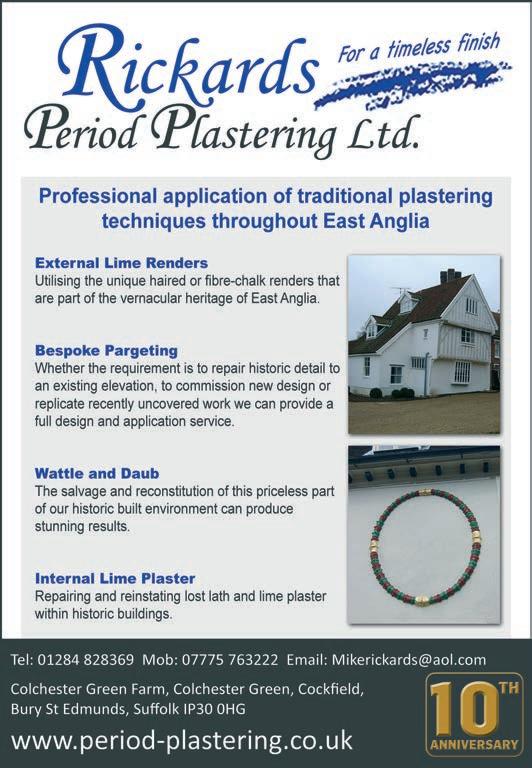


[WELCOME TO ISSUE NUMBER 100 of Ecclesiastical and Heritage World: yes, 100! That means a quarter of a century of reporting on the latest and the most interesting and exciting news stories from the divergent yet convergent worlds of church buildings and heritage sites. Those 100 issues have seen some major highs and lows, from major restoration projects to the COVID lockdown and from celebrations of craftsmanship to devastating fires. Any predictions of what the next 100 issues might witness can’t possibly do reality justice.
• The front cover of this issue carries an image that befits a 100th issue. The Cathedral of St John the Divine in New York has recently taken possession of no fewer than 2,000 of the ICON 40 chair by furniture supplier ICS. That huge contract followed years of cooperation to ensure the chairs are perfectly suited to the needs of the cathedral and are fit to carry its rose window insignia.
• The skills required to produce such high-quality items of furniture are just some of the crafts and arts needed to ensure our built heritage maintains its integrity. The skills crisis that is engulfing the construction industry is most keenly felt in the heritage sector, so the news that one of the key qualifications in the ironwork sector may be ditched next year without a replacement is of concern to anyone involved in the industry. A campaign to effect a reprieve is underway.
The metal roofing and leadwork sectors are not faring so badly, however; one of the leading training providers in the sector has recently expanded its offer.
The best apprentices in the roofing sector have also been nominated to take part in the finals of the annual SkillBuild competition, to be contested in November at Milton Keynes.
• The heritage sector has consistently demonstrated the high level of skill of its roofers in the annual Roofing Awards, and this year is no different. More than half-a-dozen heritage and ecclesiastical projects took home the gongs in various categories – aside from the Heritage category itself.
• For many churches, however, the day-to-day maintenance of the building is carried out by volunteer members of the congregation. Nevertheless, the rules of health and safety apply, particularly when working at height. Both the Church of Scotland and a leading ladder safety training provider have wise words for all churches, while the problems of DIY scaffolding towers are driven home.
• Roofs can be the resting place for more than roofers taking a breather. For centuries churches have suffered from the effects of pigeons, whether nesting or simply doing what comes naturally to all living things. The acids in bird lime can cause considerable damage, so dissuading them from roosting is a priority. That persuasion can be a complex business, particularly in light of modern animal protection legislation, so engaging an expert can be the best solution.
• All of this maintenance and restoration work costs money, whether the building is a private residence or a charity-owned property. Perversely, the expense is also subject to VAT, unlike a new-build property, although listed places of worship can claim the VAT back under a scheme due to end next year. For some years the various organisations representing the owners of historic and listed buildings have been campaigning against the imposition of VAT on repairs and restoration works, and Ecclesiastical and Heritage World has supported their campaigns. A new survey by Historic Houses illustrates the burden some owners are under.
• All the plethora of running a church is once more to be on show at CRE 2024, known as the ‘Ideal Church Show’. This year’s show, to be held in Milton Keynes, will feature the usual mix of ecclesiastical products, services and entertainment that has been featured in Ecclesiastical and Heritage World almost since issue number one. At the show, in addition to copies of the magazine being made available, visitors will be able to pick up advance copies of our 2025 wall planner to plan future activities. q
Editor, Ecclesiastical & Heritage World



[IN A TESTAMENT to its innovation and craftsmanship, Ireland-based ICS Furniture has announced the successful completion of a bespoke seating project for the Cathedral of St John the Divine, the cathedral of the Episcopal Diocese of New York. The cathedral sought a solution for their seating needs that would accommodate their diverse range of services and events.
The project involved the creation of 2,000 custom-designed chairs, tailored specifically for the cathedral’s requirements. Each chair, a modified version of ICS’s renowned ICON 40 chair, was meticulously crafted to complement the cathedral’s existing architecture, featuring a darker stain and engraved with the cathedral's iconic Rose Window emblem.
One of the distinctive aspects of the project was the opportunity for individuals to dedicate each chair as part of the cathedral’s fundraising efforts. ICS provided personalised dedication plaques for each chair.
“ICS are truly humbled that Dean Patrick Malloy and his team at St John the Divine have chosen to work with us and our chair design for their seating project,” said Gavin Duignan, the designer of the ICON 40 chair and owner of ICS Furniture. “The ICON 40 chair is designed with the end user in mind, ensuring that each chair not only meets functional requirements but also reflects the cathedral's unique identity.”
The project, completed in just over six months from sign-off to delivery, ensured the chairs were installed for Easter Sunday Mass, demonstrating again ICS Furniture’s ability to deliver bespoke furniture solutions on a tight timeline.
Dean Patrick Malloy (pictured opposite centre) commented: “Modern objects can be jarring in historic buildings, but the contrast between the classic and the contemporary, when done well, can be extremely pleasing and even evocative. ICS understands both the problems and the possibilities. Years of dynamic and exceptionally cordial dialogue between them and the cathedral is about to bear fruit. Their chairs will allow us to stage the cathedral’s diverse events – music, the visual arts, lectures, panel discussions and, above all, the worship of God – efficiently and beautifully. We are delighted that the cathedral is ICS’s first major American commission.”
The Cathedral of St John the Divine represents the latest addition to ICS’s extensive portfolio of over 3,500 projects, including 23 cathedral and basilica projects across Ireland, the United States, Canada, Italy, Sweden, Germany, Australia and the United Kingdom.
ICS Furniture is a leading provider of bespoke seating and furniture solutions, with a focus on exceeding expectations through innovative design and craftsmanship.
Celebrating 50 years in business in 2022, ICS remains a family-owned company founded by Charlie Duignan and led on by his son Gavin Duignan, who continues to drive innovation in furniture design.
Over 100 years ago, the trustees of the Cathedral Church of Saint John the Divine conceived its mission to be a house of prayer for all people, an instrument of church unity and a centre of intellectual light and leading in the spirit of Jesus Christ.
Today, as the mother church of the Episcopal Diocese of New York and the seat of its bishop, the Cathedral Church of Saint John the Divine serves the many diverse people of its diocese, city, nation and world through the worship of God, pastoral, educational and community outreach activities, cultural and civic events, international ecumenical initiatives and the preservation of the great architectural and historic site that is its legacy. q
Images courtesy of Maike Schulz, NY
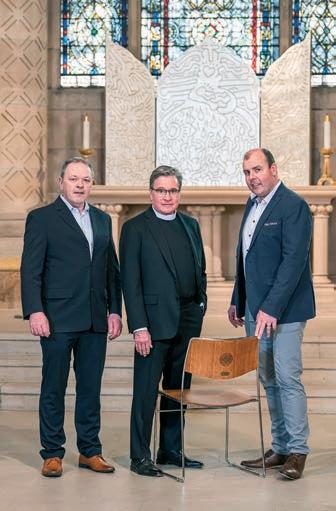

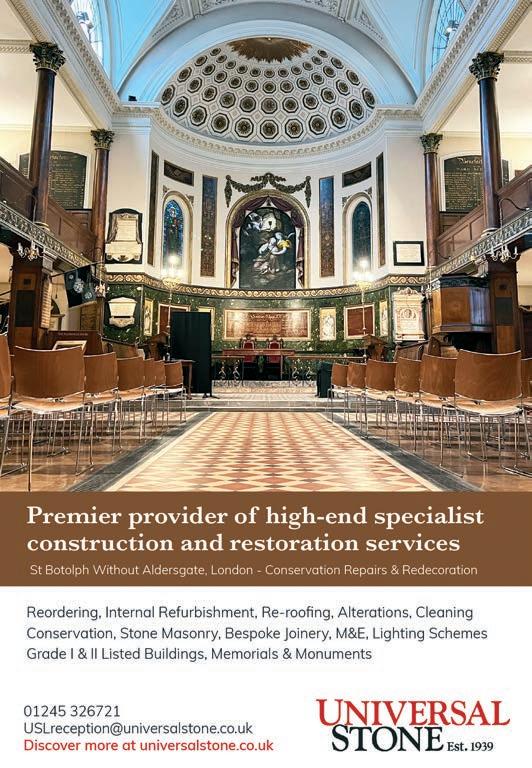


[ THIS IS ISSUE number 100 of Ecclesiastical and Heritage World: representing a quarter of a century of reporting on, initially, all the wide range of goods and services relating to the maintenance and operation of church and other religious buildings and soon after the even broader array of trades, professions and arts that keep the UK’s marvellous legacy of historic buildings – including, of course, our wonderful corpus of cathedrals and ancient churches – in order and conserve and restore those that have fallen into disrepair.

Throughout those decades the magazine has covered some of the most important restoration projects to be carried out in the past 25 years. Perhaps the most extensive of those was the restoration of St Paul’s Cathedral (pictured), a historic £40m programme of cleaning and repair carried out to coincide with the 300th anniversary of the completion of Wren’s masterpiece.
More recently – and on a secular level – the on-going restoration of Manchester Town Hall is an opportunity to showcase again the disappearing trades that understand how such buildings are created.
From its very beginning the magazine has championed the best of traditional crafts, including the Lead Contractors Association and its Murdoch Awards. The addition of the Murdoch Sponsors Award and later the Murdoch Ornamental Award have enabled Ecclesiastical and Heritage World to pay tribute to the best in leadworking craftsmanship and to Dick Murdoch, after whom the awards are named.
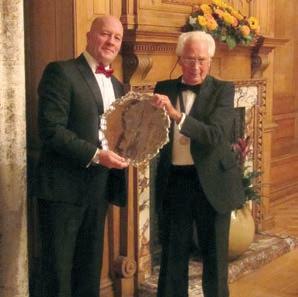
Also dating back to the early days of the magazine, Christian Resources Exhibition (CRE) has featured large in the pages of Ecclesiastical and Heritage World From Sandown Park to Manchester – just around the corner from the magazine’s headquarters – CRE has supplied the magazine with stories of all the supplies needed to run a church. And it still does, as the feature in this issue attests.
Although the title Ecclesiastical and Heritage World implies a concentration on established Christian institutions, the magazine has been proud to cover new buildings serving Islam, Buddhism and Judaism among others. Indeed, coverage of the new Temple for the Church of Jesus Christ and Latter Day Saints (Mormons) prompted a letter from that body praising the ‘balanced’ approach of the reporting.
In the past few years, however, religious services have been changed beyond recognition as a result of the COVID pandemic. For two years, not only was most restoration work put on hold, but services became ‘remote’.
What followed has been nothing short of astounding. The technologies adopted during ‘lockdown’ have been adopted by almost every religious establishment. The resultant blossoming of electronic systems designed to make worship available to all has become the latest subject of features in Ecclesiastical and Heritage World q
[ AN ON-GOING major project that Ecclesiastical and Heritage World has been reporting on is the major restoration of Manchester Town Hall – the Our Town Hall project. From its launch in 2022 there have been a number of significant milestones, and the quality of some of the work carried out has been recognised by organisations including Historic England and the Victorian Society. At roof level, the restoration efforts include dismantling and rebuilding 30 of the 34 chimneys, and replacing 140,000 roof tiles. The complexity of the roof forms, combined with the age and heritage value of the building fabric, means opportunities to provide modern roof ventilation are limited. That is where a 21st-century product comes to the rescue of the 19th-century roof. Proctor Air, an air permeable low-resistance (APLR) membrane from A Proctor Group, removes the need for separate roof ventilation. It provides a more uniform flow of air in the roof space than normal vents, ensuring there are no ‘dead zones’ where the complexity of the roof form could otherwise have restricted air movement. During the restoration carried out so far, Manchester City Council
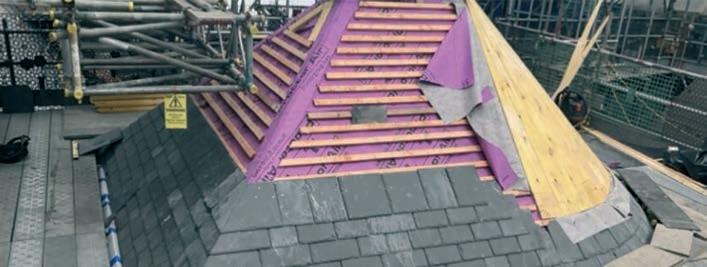
has worked to promote the ‘invisible story’ of the project – the elements of the scheme that won’t necessarily be obvious to most people, but which help to preserve the Town Hall’s heritage.
Pitched roof underlays are a true ‘fit and forget’ product. Hidden from view, they attract little interest from building users but play a vital role in protecting people from the elements, and from unhealthy indoor climates.
Proctor Air might be a modern product, but it is preserving the building’s heritage in its own way. q



[ THE ART FUND Museum of the Year prize has been awarded to Young V&A. The accolade was announced at a ceremony at the National Gallery in London on 10 July. Its director Dr Helen Charman was presented with the £120,000 prize – the largest museum prize in the world – by Vick Hope, broadcaster and member of the judging panel.
Young V&A is a museum sparking creativity now and for the future. Created with the involvement of children from early years to early teens, it is a place for young people to imagine, play and design – and get inspired by almost 2,000 toys, characters, objects and artworks on display from around the world and across history.
Dr Charman said: “This win is a clarion call for the vital role of creativity, culture and play in children’s lives when so many opportunities have been taken away through the cost-of-living crisis and on-going under-investment in creative education nationally.”
From the Isle of Dogs to Southend-on-Sea and beyond, Young V&A will work in partnership with caregivers, artists, museum professionals and early years educators to create new cultural and playful learning experiences, using its collection to unleash the power of creativity and its impact on young lives.

Jenny Waldman, director of Art Fund and chair of the panel of judges, added: “Young V&A is a truly inspirational museum. With a brief from its young co-designers to create ‘the world’s most joyful museum’, Young V&A has achieved that and more. It has radically reimagined the museum with and for young people, creating a museum experience that’s active, empowering and dynamic, centred on learning through play.”
Following its opening in July last year, Young V&A received overwhelming positive critical acclaim for its ambitious approach to child-centred museum experiences and thoughtful consideration of audience needs. Young V&A welcomed over 590,000 people in the first nine months of opening: a 223% increase on its predecessor V&A Museum of Childhood’s figures for the same period in 2019/20.
Culture Secretary Lisa Nandy commented: “This year’s Art Fund Museum of the Year was a tough competition with an exciting shortlist representing institutions from across the country. Congratulations to the Young V&A on this achievement, recognising their hard work to create a unique space dedicated to young people.”
Vick Hope said: "I was inspired by the museum’s vision to become a space for the next generation to feel empowered and to imagine their future: a space that will cement museums as places they belong and feel welcome as they grow up, regardless of their background. In such a short time the Young V&A’s global impact has been really incredible, demonstrating the potential of what museums can be for children around the world – and I can’t recommend it enough for a visit.”
The winner was one of five finalists. The other shortlisted museums, all highly commended by the judges, were Craven Museum in Skipton, North Yorkshire, Dundee Contemporary Arts, Manchester Museum and the National Portrait Gallery. Each finalist received £15,000.
The prize is funded by Art Fund’s members, who buy a National Art Pass. Pass holders enjoy discounts and benefits at hundreds of museums, galleries and historic places across the UK, while also supporting Art Fund’s vital work championing and supporting museums. q


[ IN THE CENTRE of Stoke-on-Trent is the neo-Gothic Stoke Minster – also the Church of St Peter ad Vincula. It is the main church of the city and was designated as a Minster in 2005 in recognition of that status.
For 18 months the church has been without heating, so is looking forward to welcoming local church heating specialists Mellor and Mottram on site to commence installation of new boilers. The old Clyde boilers had done many years of service but are now obsolete, so they are being replaced with two new 65KW Remeha boilers with heat exchangers to improve efficiency.
The job is ‘just around the corner’ for Mellor and Mottram, who have completed heating installations in churches and heritage buildings from Cornwall to Scotland in their 50-odd years in the business.
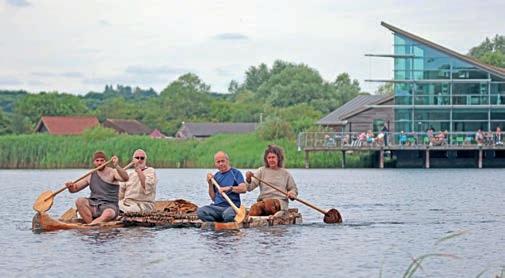
[ THE STORIES OF PEOPLE who lived at Stanwick Lakes in Northamptonshire more than 3,000 years ago were brought to life at a lively and ‘emotional’ celebration of a two-year heritage project to create replica Bronze Age log boats. Volunteers from the Stanwick Lakes nature reserve dedicated more than 800 hours to the National Lottery Heritage Fund-supported project to create the boats using ancient techniques and tools they had made from scratch.
It culminated on 21 July, when the boats were launched onto the water, cheered on by onlookers as volunteers put their creations to the test. It is believed to be the first time in 3,000 years that log boats have made a return to the waterways.
The hard work paid off as the boats remained watertight and were successfully navigated across Solstice Lake. They were joined by a Viking Karve Longship, coracles and the Northants Fire and Rescue crew to form a celebratory regatta.
Set against a backdrop of the visitor centre and the sacred Bronze Age round barrow, it was the perfect setting for the celebration of a modern-day project to bring ancient stories to life.
Becky Gill, Stanwick Lakes’ heritage manager, said the Bronze Age plays an important part in the site’s 10,000-year history, so when the National Heritage Lottery Fund awarded funding to enable the team to promote the site’s heritage, the Bronze Age seemed the perfect story to share.
She said: “We wanted to tell this story through the people who lived 3,000 years ago, to explain how they would have lived and travelled along the river to trade with other settlements. We set out to re-enact this with the help of people living and volunteering today, in the same location as our ancestors, using the same techniques and tools.” q

Not much further away, in Newcastle-under-Lyme, is St Mary’s, Knutton. That church is currently having a single 65KW boiler from Remeha installed, together with a system of modern controls.
Mellor and Mottram have prided themselves on being invited back to churches where they have carried out installations. That is now the case with St Mary’s in Market Drayton, Shropshire. Having installed a new heating system in the church three years ago, the team are now back on site at the Parish Rooms. This time an air-source heat pump is being installed, which also provides air conditioning. In addition, a fan convector provides heating in the main hall and a gas boiler will feed radiators in the toilet area.
Returning to update systems as technology develops has been a hallmark of Mellor and Mottram’s work. One of the first churches they installed a system for – back in the 1970s – was St Mary’s at Weaverham in Cheshire. Three decades later the firm returned to replace what had become an outdated system with a new, energyefficient system.
Regular readers of Ecclesiastical and Heritage World over the years will have been interested to follow Mellor and Mottram’s efforts to help churches to take advantage of developments in energy-efficient systems. q
• For further information call 0800 644 6240 or 07836 622439, alternatively visit the website at www.mellorandmottram.com

[ ARCHAEOLOGISTS FROM the National Trust and Oxford Archaeology have completed work to restore the profile of Britain’s oldest chalk figure, the Uffington White Horse in Oxfordshire.
Archaeological work last year, including the examination of previous surveys, proved that parts of the famous 3,000-year-old chalk figure have narrowed over time, due in part to the gradual encroachment of grass on the outlines of the horse and slippage of the topsoil. That was most apparent at the head and neck area, which had narrowed to less than half of its typical width.

To return the 111-metre-long horse to its typical profile, archaeologists have carefully cut the encroaching turf back to the estimated original edge and re-distributed some of the top layer of chalk on the figure.
National Trust archaeologist Adrian Cox said: “The Uffington White Horse is set in a dramatic landscape, shaped by nature and by people through time. It is a hugely important chalk figure, partly
because it is the oldest scientifically dated example in Britain, dating back to the late Bronze Age.
“It is also an intriguing figure as we don’t know for certain its original purpose. It could have been a way of marking territory or as a tribal symbol. What we do know is that, through the efforts of generations of local people, the horse has been cared for, allowing it to survive for thousands of years to become an iconic feature of this landscape.”
During the work to restore the White Horse’s profile, soil samples from the lowest layers of the figure were taken to see if they can accurately date its creation. Similar samples taken in the 1990s revealed the horse to be Britain’s oldest chalk figure, but as dating techniques have improved there is an opportunity to refine the date even further using optically stimulated luminescence (OSL) dating.
OSL dating analyses crystalline materials such as quartz or feldspar to determine the last time they were exposed to sunlight. Results of the testing are expected later this year. q
Chris Dunphy from ChurchEcoMiser reveals details of his new system

[HERE AT CHURCHECOMISER we are absolutely delighted to announce a new and additional heating system to our portfolio for heating churches. It’s an exciting and completely different type of system from anything we have offered before and one that will help you cut your running costs and provide a warm and comfortable church.
Our ChurchEcoMiser Classic system has proved to be a more than adequate carbon-neutral replacement for the traditional boiler and radiator system, but in this age of ever-changing technology, coupled with the challenges to reduce our carbon emissions, we constantly strive to improve our heating systems to meet those demands. With this new system we aim to reduce installation costs, reduce running costs, reduce maintenance costs and, of course, reduce your carbon footprint.
Our new electric infrared system, the EcoMiser Ultra, heats the congregation from high level with a series of radiant panel heaters. These heaters do not glow, so have a minimal visual impact; but they gently radiate heat downward, covering a larger area than a typical conventional radiator.
The main benefit is that infrared heating will warm all parts of your church, from the walls to the floors. That means ending cold spots, so the environment feels more comfortable. It's also a more natural type of heat, much akin to standing in the sun rather than leaning up against a very hot radiator. Because the system heats the congregation and the internal fabric without heating the volume of air, then considerably less energy is needed to give good comfort levels, which in turn means lower running costs and in most cases lower installation costs. q
• If you would like a quotation for the EcoMiser Ultra system we would be only too happy to come out and visit your church. Contact me directly if you want to discuss the system further, either by email at chris@churchecomiser.co.uk or by phone on 07770 621158.
Please note that, despite what you may have heard, we have no affiliation with any other heating companies. If you want to talk to Chris Dunphy about your church’s heating, those are the only contact details to use.

[RARE SURVIVALS of decorative paper cutting by schoolgirls from nearly 350 years ago have been found under floorboards at a historic London house. The cuttings were unearthed during renovation of Sutton House in Hackney by the National Trust in the 1980s, but were stored away until last year. The finds date to the 17th century, when paper cutting as a pastime was in its infancy in England.
The designs include a hen embellished with coloured silk, a folded star and a country couple in clothing of the period. Experts believe the schoolgirls may have been taught the skill of paper cutting by writer and teacher Hannah Woolley.
The 500-year-old property in Hackney was built for one of Henry VIII’s statesmen. Over its lifetime it was home to different families and used for different purposes, including a girls’ school in the 17th century.
During renovation of the house by the National Trust more than 30 years ago, hundreds of pieces of ephemera were found under floorboards. Last year a team of volunteers began to sort through bags of centuries-old builders’ rubble, discarded textiles, paper and bones and other objects which had been lost over time.
Among the finds was a small number of cut-out paper designs, only a few centimetres in size: some hand coloured. Eight of those have been dated to the late 17th century and are extremely rare survivals.
The cutting out of prints in the 17th century was an art form usually undertaken by girls or women and a skill that they could use to showcase their taste and dexterity. Paper folding, as exemplified in the small star identified at Sutton House, was an increasingly popular European fashion especially for elaborate napkin-folding for entertaining.
Due to the ephemeral nature of the art form, only a few examples from this time survive but the practice could well have been the forerunner to the print rooms of the 18th-century and decoupage that was popular among Victorians.
Dr Isabella Rosner, an expert in early modern material culture, identified the paper cuttings at Sutton House which are almost identical to only two other known surviving examples, one of which is a decorative box dating to the 1680s held in a collection at Witney Antiques in Oxfordshire.
She explained: “In the middle of the 17th century Hackney was the centre of girls’ education in England, and from 1657 Sutton House was a girls’ school under the lead of Sarah Freeman. It is believed that Hannah Woolley, who also established a school in Hackney with her husband, may have taught at Sutton House after she was widowed, and so it is possible the paper cut-outs identified were carried out by pre-teen and teenage girls under her tutelage.

“The prints found underneath the Sutton House floorboards are hugely exciting, as they give us glimpses into the rich material world of middle and upper-class schoolgirls 350 years ago.”
The paper-cuttings are on display at Sutton House until December; visit www.nationaltrust.org.uk/sutton-house q
Images: National Trust Images – James Dobson

[
HISTORIC HOUSES – the representative body for 1,450 Grade One and Two-listed independently-owned houses, castles and gardens across the UK – has been seeking the views of heritage destinations with listed buildings to find out how much they pay in VAT on repairs, maintenance and restoration.
Historic Houses hopes the findings will be instrumental in guiding policy for the whole heritage sector, helping to highlight to government the economic and cultural benefits of implementing a VAT rebate scheme for heritage destinations. Currently, the financial burden of VAT on such essential works can be significant, often impeding the preservation and maintenance of the historic structures, which contribute to the character of our places and which also attract tourism and investment to the UK.

The research, conducted for Historic Houses by Harlow Consulting, will show the potential level of need and the benefits such a rebate scheme could have.
Sarah Roller, policy manager at Historic Houses, said: "Heritage properties open to the public deliver a huge amount of economic benefit as well as genuine pleasure and enjoyment for millions of people. We feel they should be supported by government with a more supportive VAT regime on their repair and maintenance. It's been an extremely tough economy for all in the tourism and heritage sector, with the costof-living crisis compounded by the shortage of skilled tradespeople in the sector.”
A rebate scheme would mean that heritage buildings are treated in parity with new builds, which can already claim VAT rebates.

All those who own or manage heritage destinations that are open to the public for 28 days or more per year were urged to take part in the survey.
The questions relate to five main themes: basic details about the heritage property, the impacts of VAT, the condition of the heritage property, the cost of repair works and the place of the property in the wider community.
Historic Houses members welcomed over 21 million visitors in 2022, generating over £1bn for the economy, and supported over 32,000 fulltime-equivalent jobs.
Its member houses range from iconic mansions such as Blenheim Palace, Highclere Castle and Knebworth House to more intimate houses such as Traquair in Scotland and Treowen in Wales.
It has been campaigning for tax reform on behalf of the heritage sector for the past two decades. It estimates the backlog of repairs and maintenance across the 1,450 properties it represents at around £1.38bn. q
[ON 11 JUNE Blackburn Museum and Art Gallery celebrated its 150th anniversary. It was one of the very first purpose-built free museums to open outside London and as such the laying of its cornerstone in 1872 was a grand affair filled with ‘pride and pomp’.
“At three in the afternoon, the celebrations began,” an extract from Notes on the planning and construction of Blackburn’s Free Library, Museum & Art Gallery reads. “Anyone who was anyone in the town was involved.”
A 1,023 square yard plot off Richmond Terrace had been purchased for £1,120 and a competition held to find a design. In total, 38 entries had been submitted with eminent London architect Alfred Waterhouse judging Knowledge is Power by Messrs Woodzsell and Collcoutt of Finsbury Place as the ultimate winner.
The construction of the impressive building was undertaken by Messrs Marshall and Dent of Blackburn and the final bill for the works came in at £8,424.
Such was its popularity that it was soon extended and, in the 1970s, Blackburn Library moved to Town Hall Street to provide even more space.
Today, visitors can enjoy an impressive collection of important art, a fascinating Egyptian gallery and a wealth of items relating to social and natural history.
It’s still very much free to enjoy, too! q
During the 1950s the sanctuary of the Grade Two-listed Oratory Church of St Aloysius Gonzaga was reconfigured, the high altar was simplified and moved forward and all the polychrome decoration was over-painted. To restore its lost beauty, two large murals by Gabriel Pippet have now been uncovered. Polly Westlake, conservator at Cliveden Conservation, explains more about the project.
[THE GRADE TWO-LISTED
Oratory Church of St Aloysius Gonzaga was built in 1875 by architect Joseph Hansom and uses beauty to raise hearts and minds to God, faithful to the traditions of St Philip Neri and St John Henry Newman.
The Fathers of the Oratory plan to return this beauty to the public by restoring the original plan of the sanctuary ahead of the church’s 150th celebrations in 2025. That will include installing a beautiful new high altar, restoring the nave and extending the church.
The first phase of works – St Aloysius Revealed – began back in 2022 and has been an exciting journey. The church had been under the impression that the murals were in poor condition and that redecorating with a new scheme may be the best option. However, the trials carried out by Cliveden Conservation with Owlsworth IJP revealed the original scheme beneath the modern paint to be in good condition. Within just a short space of time small panels of colour, details of stencilling and gilding could be clearly seen.

achievement and an important milestone in returning the beauty back to the sanctuary of the church. It has unlocked details of vibrant colours, gold leaf and exquisite patterns used by Pippet throughout the sanctuary, which is not only key to the whole restoration but also representative of some of the finest decoration of the Catholic Arts and Crafts movement. With the faces of the saints once again looking out from the murals onto the sanctuary, the church can communicate a strong sense of tradition to everyone who visits and create an inspiring and beautiful place of prayer. The church can also demonstrate the potential and viability of the wider restoration project, attracting valuable attention, funding and support from the community. q
• For more information visit www.clivedenconservation.com
At the start of 2024 Cliveden Conservation was invited back by the Fathers of the Oratory to uncover both of the murals. To limit the disruption to the church services, two tower scaffolds were erected at the sides of the sanctuary to enable conservators to work on the murals simultaneously.

Arbocel (paper pulp) was used to hold de-ionised water against the surface to soften the modern paint so it could be carefully peeled away without damaging the underlaying paint layers. It was incredible to not only see the murals surface but also to find them in very good condition.
There was an area of loss on the north wall to the non-figurative decoration, which needed repairing and recreating. To achieve this, conservators traced existing motifs and transferred them to the repaired plaster surface using acrylic paints. There was also a damaged figurative scene on the south wall which was painstakingly reinstated.
Restoring the lost murals of Gabriel Pippet that depict the life of St Aloysius Gonzaga, the patron of the Oxford Oratory, is a remarkable




[MORE THAN 150 organisations will be waiting to meet visitors to CRE 2024, taking place in Milton Keynes from 9-10 October. The latest event from the Christian Resources Exhibition stable will be offering everything from contactless card machines to customised keyboards, heating to seating, clergy clothing to communion wine.
CRE provides a great context for networking and creative thinking. It really is a one-stop-shop for church supplies, resources and ideas.

Highlights of the show will include the Worship Stand, which this year will see composer and performer Roger Jones join fellow worship leaders
Chris Bowater and Lou and Nathan Fellingham.
The exhibition also features a packed talks programme, with dozens of presentations by national experts offering practical advice on a range of subjects – from fundraising to faithsharing; holiday clubs to homelessness.
Those planning to visit the show can let fellow worshippers know about the opportunity by downloading an A4 poster for their church notice board from the CRE website.
“While thousands of people on our mailing list have been to several exhibitions, there are many more, in hundreds of churches within a short drive of the Marshall Arena, who have never even heard of us,” said CRE owner and MD Steve Goddard. “There is nothing like a colourful poster to pique their interest!”
Making personal, face-to-face contact with experts in their field is the unique value of CRE, as Rev Geoff Bentley of Aintree Baptist Church in Liverpool found out last year. He met Mark Newall, director of BCHN Architects, at CRE 23 in Solihull. Their conversation led to the practice being invited to plan the remodelling of the Victorian-era building.
“We are now progressing the design towards a planning application via our collaborative design process,” said Mark.
The whole congregation has been involved in the planning process, with company experts
[ WORLD-RENOWNED professional football freestyler Daniel Cutting will open CRE 24 at Milton Keynes in October – and remind visitors how churches can use sport as a vital bridge to their local communities.
Daniel, who lives in Milton Keynes, specialises in live entertainment, product launches, corporate events, social campaigns, commercials – and even the occasional school assembly! A 10-times Guinness World Record holder, he has more than five million followers across social media and prides himself on providing the highest-quality form of football entertainment.
He has been working as a full-time football freestyler since graduating from university, with his skills taking him to more than 40 countries. He has the ability to provide entertainment and, depending on the occasion, tell audiences about his Christian faith.
“I was delighted to be asked to open CRE,” he said.
Dan has honed and perfected his skills, as well as developing his own unique style, and takes inspiration from other creative art forms, such as break-dancing and gymnastics, which he incorporates into his shows.
He realised that the determination, discipline and dedication needed for football freestyle was not only something to be admired but could also inspire others. He therefore encourages individuals not simply to take up football freestyle, but also to share those qualities while emphasising the importance of a healthy and active lifestyle which, when embraced, will help anyone to succeed. q

holding a series of meetings to determine individual church members’ views.
That kind of opportunity to meet with the whole contingent of product and service providers, together with enjoying a plethora of entertainment is available at the Marshall Arena, next to Stadium MK, from 10am-5pm on 9 October and 10am-4.30pm on 10 October. To purchase tickets visit www.creonline.co.uk q
[CRE HAS TAKEN to podcast technology to introduce visitors to some of its key exhibitors and what they do. The first of its podcasts, posted on YouTube in July, is an interview with Ann Hatton, of leading charity Ripple Effect.

Formed in 1998 under the original title Send a Cow, the organisation helps farmers and families in six east African countries discover the benefits of growing their own food and passing on the skills learned to others.
Ann (pictured), who has been connected with the charity for more than 20 years, got involved with the charity because she wanted to play her part in trying to end global poverty. In the podcast she relates how CRE is a key platform at which she can introduce church leaders and individuals to the work of Ripple Effect.
“We are delighted to make Ripple Effect our first showcase podcast,” said CRE event director Brett Pitchfork. “While we are constantly promoting news from our exhibitors in CRE News, over the next few months the CRE Podcast will provide an opportunity for a deep dive into several organisations across the many vertical sectors on the exhibition floor.”
The second interview to be posted is with Kingdom Coffee's Darren Rayner. Kingdom Coffee’s sales of Fairtrade tea and coffee help to maximise its donations to the Toybox charity. q
[ ONE OF THE MOST frequent changes made to churches that Ecclesiastical and Heritage World has seen in its quarter-century of publication has involved seating in some way, and changing the seating inside a church can have a significant impact upon the interior.
Whether to change the seating in a church is a major decision and should not be undertaken lightly. Indeed, this issue’s front cover illustrates the transformation a well-designed seating scheme has brought about at New York’s main cathedral.
The Church of England has issued guidance, via its ChurchCare programme, outlining when the seating can be changed and when current seating should be preserved.
The guidance states: “The decision to remove pews should be made on a case-by-case basis following careful assessment of significance, needs and impacts. If the decision is taken to replace existing seating in a historic church building, then the Church Buildings Council aspires to seeing replacement chairs or benches of the highest quality of design.
“Changes will require a faculty and, due to the presumption against any change that will adversely affect the character of the church as a building of special architectural or historic interest, applicants are required to demonstrate sufficient need for change.”
The guidance points out that certain types of seating can be more meriting of preservation because of their position within the church.
“It is worth noting that collegiatewise chancel stalls are often of higher quality and significance so their retention is often desirable. Doing so not only facilitates the retention of some of the original character of the church, but also retains a formality at the east end of the church and preserves interior views. Even though there may no longer be a robed choir using the stalls, the pews can be used for smaller midweek services and as a quiet worship area.”
The ChurchCare guidance document, which is statutory guidance under Section 55(1)(d) of the Dioceses, Mission and Pastoral Measure 2007,

goes on to explain the measures that need to be taken into consideration. The guidance can be downloaded from www.churchofengland.org
Aside from seating, modern church furniture can reflect both technological advances and modern aesthetics. Recent issues of Ecclesiastical and Heritage World have illustrated many instances where state-of-the-art lighting and audio-visual systems and the accompanying controls have been housed in attractive furniture. Even the traditional basics of service such as lecterns and altars have been designed to hide the electronics needed to carry voices to a congregation.
In other cases, the written word is all that needs to be conveyed, and traditionally-made hymn boards and notice boards fit the bill perfectly. q
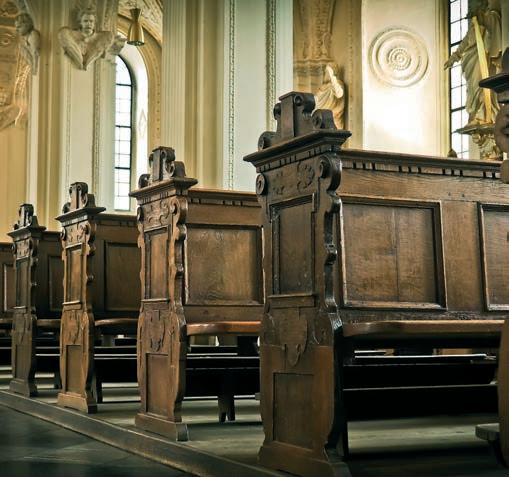
[EARLY CHURCHES had no fixed seating, as worship was always carried out standing, but sometimes had stone benches around the walls and pillars for the old and infirm. In other cases there were merely shelves to lean on, or pull-up seats known as misericords supported on corbelons. These corbelons were often lavishly carved with domestic scenes, offering an insight today into medieval life.
The first purpose-built seating in churches appeared around the end of the 13th century. Originally they were simple benches without backs, but gradually backs and ends were added. The bench ends were also routinely carved with everyday events – and also some garish characters.
The Reformation led to the introduction of what we now recognise as pews. Those pews became ornate and even enclosed and there developed a hierarchy: the notable figures in the parish would occupy ‘family pews’, which were inevitably the most lavish and at the front of the nave.
A major upheaval occurred in the middle of the 20th century, when modern churches began to introduce chairs instead of pews and older churches liked the versatility they offered. The rest is history in the making. q
[WITH OVER 50 YEARS of combined trading experience, ChurchChairsDirect stands as a beacon of quality and integrity in the ecclesiastical furnishings industry.
Their commitment to excellence is reflected in every product manufactured and assembled in their factories in Northern Ireland and the North West of England. Their dedication to the highest standards is further demonstrated by the use of UK-sourced sustainable materials that meet stringent UK specifications.

Potential customers are invited to visit their showrooms in Liverpool and just outside Belfast, where they can experience at first hand the superior craftsmanship and thoughtful design that go into each piece. Whether you are seeking off-the-shelf solutions or bespoke interior design and fit-out services, ChurchChairsDirect are equipped to meet your needs with unparalleled expertise and attention to detail.
Company principal John Kirkpatrick explained: “At ChurchChairsDirect we pride ourselves on sourcing materials from local, sustainable suppliers: ensuring that our environmental footprint is the minimum possible. Unlike many of our competitors, we choose not to source our products from China or India, instead opting for reliable European partners who share our commitment to quality and sustainability. This ensures that every product – from wooden and metal chairs to high stacking chairs, lecterns, pulpits, pews and sound desks – is crafted with the utmost care and integrity.
“Our bespoke interior design and fit-out service for ecclesiastical
buildings is a testament to our versatility and commitment to tailored solutions. By visiting www.churchsuppliers.co.uk you can explore our comprehensive service offerings and see how we can transform your vision into reality.
“For those seeking ready-made options, www.churchchairsdirect.co.uk provides a wide range of high-quality products available for immediate purchase.
“One of our standout services is our 3D design capability, allowing us to produce coloured drawings of proposed furniture, giving you a clear and detailed visualisation of your project. This, combined with our lifetime structural guarantees on manufactured products and our use of commercial-grade foam and upholstery fabric that meets all relevant regulations, ensures that you receive not only beautiful but also durable and compliant furnishings.
“Additionally, we offer factory direct prices on flooring, further enhancing the value we provide to our customers. Samples are available upon request, allowing you to make informed decisions about your purchases.”
Serving the United Kingdom, Ireland and parts of mainland Western Europe, ChurchChairsDirect is a trusted partner for all ecclesiastical furnishing needs. Their dedication to quality, sustainability and customer satisfaction sets them apart in the industry. q
• For more information, or to discuss your specific requirements, contact 0330 133 6563, email info@churchchairsdirect.co.uk or info@churchsuppliers.co.uk


[ ELMWOOD CHURCH is a large family church in the heart of Salford with both a lively and friendly mix of people of all ages who welcome visitors and newcomers and a rich history, dating back to 1889.
In 1987 Elmwood embarked on an ambitious project to build a new church, moving to its current site on Eccles Old Road. With over 30 years of ministry in the building, the church gained new members –firstly as Christians, but also from a variety of church backgrounds. Such an expansion brought with it a need for an increase in seating capacity and in 2022 Rosehill Contract Furniture worked with Elmwood Church to supply new contract furniture for their place of worship.
Rosehill supplied 200 of its Urban Stacking Chairs with the optional links included: 12 of which were armchairs. The Urban Lightweight Stacking Chair is one of the most popular multi-purpose chairs from Rosehill for many reasons. Not only is it lightweight, making it easy to move, stack and store, but it’s also durable, making it the perfect solution for a busy environment with heavy footfall. Elmwood is a busy family church where having furniture that offers flexibility and ease of use is essential.
The optional linking means that chairs can be linked seamlessly, while the additional armchairs offer extra support. Elmwood ordered the Urban chairs with the Havard fabric in Ink, which is a classic and timeless premium fabric option with a stainresistant and flame-retardant finish.
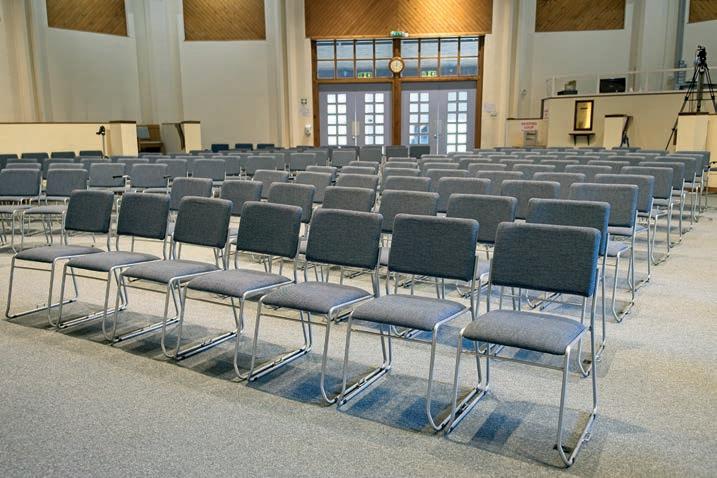
Alongside the 200 chairs, Rosehill also delivered an H100 Chair Trolley, which allows the customer to easily move a stack of up to 10 chairs at once.
Elmwood Church has an impressive space in its auditorium which originally had solid wood pews. The church felt that it limited the use of the best space in the building and therefore wanted to replace the pews with chairs so that the space was versatile, making it ideal for different events. Since upgrading the furniture the space has been used for children’s holiday clubs, toddler Christmas parties, local community celebrations and a Christmas panto. Having multi-use chairs and transport trolleys makes it really easy to clear the space and store the furniture when not in use.
Church administrator Fi Mellor explained: “The pews were dated and we wanted to update the seating and make it more

contemporary. We are in the process of a rebrand so wanted the seating to tie in with this project. We love our new chairs – the colour, the design. Rosehill were great at listening to our needs and allowed us to change the shape of the chair back to make it more modern.”
Having spoken with Elmwood Church as part of their integral aftercare service, the team at Rosehill were delighted to hear that great feedback. But they also wanted to follow up and get a deeper understanding of ‘Why Rosehill? What makes us stand out above the rest?’
Some answers were:
• Because they were local to Elmwood – Rosehill is based in
• Cheshire – they were able to supply sample chairs, allowing
• them to get feedback from the congregation before purchasing.

• They had a quick turnaround time: the chairs they supplied are
• from the UK and therefore the delivery time was reasonable.
• The price was competitive – something Rosehill always prides
• itself on.
• Excellent customer service: “Big thanks to Jo for keeping in
• touch, sending out samples and being patient with us while we
• decided on design and colour.”
In fact, the church were so pleased with their new chairs they placed a follow-up order this year and took delivery of a further 40 chairs this summer.
If a church, place of worship or community centre is in need of new contract furniture, they can get in touch with Rosehill’s sales representatives, who can discuss the exact requirements and invite them to their purposebuilt showroom or supply sample chairs to help with the decision. q




[ONE OF THE UK’S leading UK notice board manufacturers is Greenbarnes. They have an innovative yet traditional approach to delivering quality noticeboards, signage and street furniture.
In 1990 they became the first company to revive the manufacture of wooden village boards, establishing themselves as a pioneer in transforming the industry into what it is today.
Catering to an ever-expanding market, the company offers a wide range of boards, both standard designs and custom-built. All are available to order at www.greenbarnes.co.uk
The site is interactive, allowing visitors to choose from a range of features available to select digitally and add to baskets or wishlists.
Company director Lyn Boardman explained:
“Here at Greenbarnes we recognise the importance of longevity, hence all our products are built to last. We have consistently taken a traditional approach concerning manufacturing and continue to ensure the business operates by these values.
“All our boards are manufactured in the UK, ensuring higher quality products that are tailored to each customer – giving a personal touch to the customer journey.
“The materials used for each board are chosen with careful consideration. We work with esteemed materials suppliers such as Tricoya to ensure unmatched quality.”
The company’s range includes:

Lyn Boardman continued: “Longevity cannot exist without quality, and we consider all possible concerns that can affect the durability of our merchandise. All Greenbarnes boards have built-in weatherproof filters such as seals and ventilation to minimise condensation – remaining mindful of Britain’s climate. Tricoya wood is used on all oak boards for back panels: this reputable brand has moisture-resistant qualities, perfect for withstanding wet weather.

• Oak notice boards, made with European oak to ensure a smoother
• finish. This oak is often used in fine furniture making and provides a
• noticeably high-quality look. It is also more sustainable than, say,
• English oak as it creates less waste.
• Man-made timber notice boards, which come free of common
• problems that are typically associated with timber boards and are low
• maintenance. Made from recycled plastic of the highest quality, man-
• made timber has a traditional appearance.
• Aluminium notice boards that are made to thrive in both prestigious
• and challenging locations, maintaining a stainless, brushed, flawless
• finish. The standard display panel is also magnetic and has weatherproof
• features. Aluminium boards are available in many sub-categories that
• differ in features required for the specific needs of each consumer.
• Internal notice boards that are a long-lasting and budget friendly
• solution for public buildings, offices or schools. The hand-crafted
• designs can blend into any aesthetic. Each board has features like
• lockable doors, shatterproof glazing and magnetic materials.
• Honours boards that are of the highest quality, with lettering badges,
• crests and coats of arms applied with computer-cut vinyl and frequently
• made from oak.
The boards offer a fusion of traditionalism and intelligent design, marrying over 30 years of hand-crafted experience with the best of traditional and modern materials.
“In recent years many businesses across all sectors have become more environmentally aware. Sustainability is one of the key components of our company values. An example of our commitment is that all oak used comes from a European FSC-certified source. That means sourcing timber from responsibly managed forests and utilising a range of recycled materials for countless products, successfully meeting the product and service needs and beliefs of customers who appreciate environmentally conscious practices.”
All Greenbarnes’ products are hand-crafted in their production unit. Within that context, the brand delivers a creative use of modern materials available in a variety of sizes, styles and finishes calculated to cater to the needs of churches and places of worship.
The boards are traditional in look and feel, but with none of the traditional problems due to product quality and carefully considered features. To discover the complete range of products for churches visit www.greenbarnes.co.uk/products-for-churches-gallery/
Greenbarnes products are budget friendly: The products come in various prices to inclusively fit the budgets of customers while maintaining excellent value for money, with prices starting as low as £76.
They are weatherproof and durable: The boards are hand-made by skilled cabinet makers and are assembled and finished to order. Their durability can be attributed to weather protection features, such as polycarbonate glazing that is anti-UV coated on the interior and exterior, while glazed boards contain integral ventilation to reduce condensation. A microporous stain finish is applied to European oak boards, meaning they require less frequent maintenance.
They are secure: Features such as robust locks and easy-grip keys, stainless-steel piano hinges made from stainless steel and secure antishatter glazing are included – and they come with a five-year warranty.
Greenbarnes also supply a collection of outdoor furniture, crafted from recycled plastic made to withstand the elements.
Lyn Boardman concluded: “The collection includes benches, planters and picnic tables. Due to the high quality of the materials used these items do not require any varnish or staining. We supply bespoke and customisable products that can be used to elevate public spaces or celebrate an event.” q


[A NEW audio-visual installation – Layers of Time – opened at 16 New Street in St Helier, Jersey over the summer has allowed visitors to discover the remarkable story of how the building fell into decline over the centuries.
Two decades ago 16 New Street sat boarded up and neglected, its splendour as one of the finest 18th-century townhouses in St Helier concealed beneath layers of paint, pigeon detritus and discarded shop fittings. Due to the perilous condition of the building, the future of 16 New Street was uncertain until the National Trust for Jersey invested over £1m in a groundbreaking transformation that required incredible skill, ingenuity and resilience.

Layers of Time brings to life the story of 16 New Street told through its inhabitants. As the visitor travels forwards in time from the building’s construction in the 1730s they are introduced to residents from the past: Ann Journeaux, who lived in the house in the early 1800s; Henry and Edith Le Gros, caretakers of the YMCA who resided at 16 New Street during the Occupation era. As the mood of the exhibition changes from joy to despair, visitors experience the building’s demise from a luxurious
[ISCVE HAS ANNOUNCED a new date for its Making Waves –
Acoustics Essentials training course, with limited places available. The new date is 11 September at 9.30am. The venue is Shure UK’s headquarters at Waltham Abbey in Essex and the course will be led by Tony Stacey BSc MIOA(E) FInstSCVE, an expert with many years of acoustic experience.
The course is designed to provide a deeper understanding of sound beyond the loudspeakers. It is ideal for technicians, newcomers to acoustics and experienced professionals who need a knowledge refresher.
Engineers and technicians need to understand the journey of sound for several reasons. Optimising sound quality, designing effective sound systems, troubleshooting issues and complying with industry standards all depend on a comprehensive understanding of how sound behaves in different environments. The course addresses those needs by covering essential topics, ensuring that delegates have the key principles in hand to guarantee they can deliver perfect auditory experiences in any space.
The course will cover a range of topics, including:
• Understanding what sound is and how it travels
• The relationship between the speed of sound, wavelength and
• frequency
• Amplitude and its implications
• How the decibel works
• Equal loudness contours and frequency weighting
• Propagation of point, line and plane sources
• Air absorption, reverberation and absorption
• Diffraction, interference, temperature and the speed of sound
• Refraction and the Doppler effect
The price for ISCVE members and supporting members is £180 for a single or £162 for multiple bookings and £250 for non-members. Visit iscve.org.uk/training-course-acoustics-essentials/ to book. q
residence to a derelict ruin – and back again – as the team of craftsmen who were intimately involved in the building’s restoration tell their stories of how they brought 16 New Street back to life.
Catherine Ward, museums manager at the National Trust for Jersey, explained: “Layers of Time pays tribute to the people who lived and worked at 16 New Street. As visitors experience the stories of the past, and discover what might have been lost were it not for the intervention of the trust, we hope they will feel empowered to do more to save Jersey’s historic buildings which are still at risk today.”
The exhibition opened on 7 June. q


Rob Alvis of Creative Audio-Visual Solutions (CAVS) looks
[IN THE PAST there have been numerous articles where comparisons have been made between projection and TV-style displays. Now that there has been a number of notable technology developments within all sectors, it seems a good time to revisit the subject.
When a church is looking at an audio-visual system, the discussion between what type of display or screen is probably the first item on the agenda. So let’s look at each technology in regard to what the latest developments have been and the all-important pros and cons.
Most churches have used some sort of projector in the past, so this is not a new technology: although recent advancements are worth highlighting. Previously, projectors used lamps as their light source –those are prone to brightness degradation from the moment you turn the projector on and within a year there will likely be a noticeable dropoff in performance.

Bearing in mind a lamp should be changed every 3-5 years, depending on usage and ambient conditions, such as temperature and humidity, that type of projector only really gives out its best for a third or less of its life. Much like within the vehicle industry, the big change is the main ‘engine’ –or in this case the light source within projection.
Lamps have now been replaced with laser technology, which will run for the life of the projector – so no issues regarding lamp failures just before or mid-service! Yes, there is brightness degradation, but this is so slow it is almost unnoticeable during the lifespan of a church-based projector.
Where projectors have a bad name is the under-specifying of a system based on screen size and ambient light levels. With falling costs it is far easier to get the right projector, with the correct brightness levels, for a particular situation; and therefore they should now be more comparable with ‘TV’ quality in terms of image quality.
With all things equal, pros as they stand will be: good viewing angle, ability to hide a screen away or project onto a bare wall and the ability for larger screen sizes – typically above 2m wide. The cons would be increased maintenance (filters), negative effect from high ambient light or direct sunlight, fan noise if the projector is in a position close to the congregation and brightness/image quality if the correct projector cannot be afforded.
For most, these are ‘TVs’: fixed screens of certain sizes. The two main technologies are LED and IPS. Without going into detail, there are benefits with both; but for church applications they are less relevant.
Commercial displays are recommended, both in terms of performance, reliability and warranty – and with new anti-glare displays available they do provide exceptional image quality and performance in high ambient light conditions. Domestic TVs are very much a budgetary consideration and due to glass or high-gloss panels, they provide poor performance with light reflection/viewing angles.
The main downside with fixed displays is that there is no hiding a big black panel when not in use. Yes, you can use screensavers and backgrounds; but you can’t hide them away or disguise them easily. Within the more modern church that is less of an issue and in more traditional churches they are popular as repeater or ‘behind pillar’ displays where perhaps the main projection screen is obscured.

In most situations they do provide the best image quality – certainly when it comes to price – but there needs to be a consideration in terms of mounting. Screen sizes are generally available from 19” to 98”. Displays at the larger end can weight close to 100kgs each, so that needs to be considered in terms of placement and accessibility.
Due to cost, these have only recently become an option for some churches. They are the type of displays you will often see at sports stadiums, advertising hoardings and shopping centres and the like. They consist of a number of smaller ‘tiles’ which together can create a virtually limitless size of screen. Like TV-style displays, they cannot be hidden and will require even more involved mounting hardware and fixing consideration; but for the most striking images, due to high brightness LEDs, they cannot be beaten. If you want a very large seamless display or backdrop with no shadowing or negative effects from ambient light, a video wall is the only real option.
Returning to cost, which will generally start or end the conversation, you will usually be looking at £25,000 upwards for a 3m display with high-definition resolution. For a large backdrop you can quite easily move into six figure costs.

Here at Creative Audio-Visual Solutions, we have vast knowledge and experience in all those technologies. A discussion at your building will quickly ascertain the right solution: indeed there may be options for more than one which may then come down to cost and/or aesthetics. q
• For a free on-site consultation, or to begin the conversation, get in touch. ‘Like’ us on Facebook (Cavsolutions) for the latest installation case studies and product news, tel 01707 518400, email sales@cavsolutions.co.uk or visit www.cavsolutions.co.uk




[ THE Institute of Sound, Communications & Visual Engineers (ISCVE) has announced details of the event all professionals in the sound, communications and AV industry should attend: the ISCVEx 2025 exhibition and seminar event will be taking place on 25-26 March 2025, at the prestigious Coombe Abbey Hotel in Warwickshire.
The two-day industry event brings together experts, manufacturers and installers to showcase the latest technologies and innovations in the industry. With a packed schedule of seminars, discussions and networking opportunities, ISCVEx 2025 is a must-attend event for anyone engaged in the world of sound, communications or AV.
AGM and Members’ Day : Engage with ISCVE members and enjoy a presentation from an industry leading figure.
Networking Dinner: Connect with industry friends, colleagues and peers in a relaxed social environment with live entertainment.
Seminar Programme : Hear from top-tier speakers and engage with industry thought leaders.
Exhibition : Discover innovations and the newest products from 30-plus industry organisations.
The ISCVE's Annual General Meeting (AGM) and Members’ Day, scheduled for the first day of the event, will feature an engaging presentation and the formalities of the Annual General Meeting. The renowned networking dinner, taking place after the AGM and Members’ Day, allows those registered to attend the opportunity to relax and network with industry friends and colleagues.
On the second day of ISCVEx 2025, the focus shifts to three key seminars, each presented by leading figures within their field, and an exclusive exhibition featuring over 32 industry manufacturers and distributors. Visitors can explore and engage with the latest developments and offerings in sound, communications and audio-visual technologies.
Paul Dougherty of Blaydon Communications commented: “I’ve been to ISCVEx on many occasions, and it just keeps getting better and better. It’s a one-stop-shop for all your peer-to-peer networking with industry associates, and the best place to learn about the latest products from all the important manufacturers in the sector.
“The mini-seminars are always interesting and insightful and the lunch they put on isn’t too bad either! The venue is amazing and the organisation by the event management staff at the ISCVE is second to none. Really looking forward to ISCVEx 2025.”
ISCVE is dedicated to nurturing a welcoming environment for industry advancement and networking. Media representatives, ISCVE members, non-members and all industry experts are encouraged to join them at this fusion event of educational insights and industry showcase.
Join them in shaping the future of the sound, communications and visual engineering industry. Your contribution matters as they pave the way forward together. q
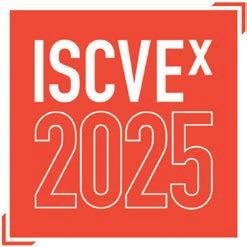



[WITH TECHNOLOGICAL ADVANCES over recent decades, people are now used to high-quality sound and audio-visual systems in their homes, in their cars and on the move. That progression in domestic and personal audio quality has been echoed by advances in professional sound and AV, for all types of venues and locations. Whether we are being informed by an announcement, listening to a speech or enjoying the restaurant atmosphere, the excitement on the dance floor or at a live concert, the professional sound and AV is an all-important ingredient.
Richard King Systems are established and recognised specialists in the field of professional sound and AV systems. For four decades they have been at the forefront of harnessing the capabilities of professional sound and AV technology, to produce first-class performance. With their extensive experience in designing, installing, commissioning and servicing of all types of professional systems they are able to work with clients to create the desired environment for a wide range of commercial sound and AV systems, with the value, quality and reliability that operators and listeners now expect.
The firm’s portfolio includes a wide range of projects, including major works at St Asaph Cathedral in North Wales, St Mary’s Church in Welshpool, Powys and Shrewsbury Abbey. They have also provided the sound and AV services for the newly completed £2.4m Lighthouse Church in Heswall, Cheshire. Recently completed projects have also included the Grade Two-listed Christ Church at Bryn-y-Maen, just outside Colwyn Bay in North Wales. The church is known locally as ‘The Cathedral of the Hills’, having been erected by Mrs Charles Frost – a local lady well known for her generous and liberal support of religious work – to perpetuate the memory of her late husband. Richard King Systems designed, installed and commissioned a complete sound system, including an audio loop system to the recognised standard


In Shropshire, a sound system upgrade has been installed at All Saints Church, Gobowen. Part of the improvements were new loudspeaker cabinets to significantly increase the speech intelligibility, despite the challenging reverberation. The control equipment was also replaced to provide easier-to-use controls for more reliable operation and significantly better sound reproduction.
Company manager Richard Hughes explained: “Richard King Systems specialise in the design, installation and support of integrated professional sound, AV and lighting solutions. Founded in 1977, we have a proven track record of many successfully completed projects. We utilise our expertise in delivering first-class, efficient and cost-effective solutions for our clients. In doing so we aim to foster and maintain long-term, mutually-beneficial relationships with both our clients and our suppliers. We provide services as consultants, specifiers, designers, installers and trainers for all types of associated systems.
“With our vast experience of installation in listed buildings gained over many years we bring considerable expertise to projects. In particular, the project at St Asaph Cathedral involved us in substantial consultation, design and planning, working with the cathedral’s team over a long term.”
That system has been widely acclaimed, with the cathedral’s Canon for Communication, John Liston, commenting: “The new sound system is wonderful…it has been transformational.”
Richard King Systems are SafeContractor accredited and are supporting members of the Institute of Sound, Communications and Visual Engineers (ISCVE). As supporting members they work with the industry to improve the technical standards, knowledge and practices of sound, communications and visual installations. Their installation staff are ECS (CSCS) card holders and CRB/DBS checked, and include engineers registered with ISCVE as approved hearing loop assessors. q
[EVERY LOUDSPEAKER in your house of worship can be repurposed, repaired and restored at very low cost. That’s the message from Andrew Bishop, founder and managing director of Reclaim Audio.
Repairing speakers instead of leaving them in a corner or discarding them in landfills has numerous environmental, economic and social benefits that align with sustainable practices and responsible behaviour, he explains.
The most significant reason to repair PA speakers is to reduce environmental harm. Electronic waste, known as e-waste, is a growing global issue, with millions of tons ending up in landfills each year. PA speakers, like other electronic devices, contain hazardous materials such as lead, mercury and cadmium, which can leach into the soil and water, causing severe environmental pollution and health risks to humans and wildlife.
By repairing and reusing those speakers, we can minimise the volume of e-waste, thereby reducing the release of toxic substances into the environment.
Manufacturing electronic devices consumes considerable amounts of natural resources, including metals, plastics and rare earth elements. The extraction and processing of those materials have substantial ecological footprints, involving energy-intensive processes that contribute to greenhouse gas emissions and environmental degradation.
Repairing PA speakers extends their lifespan, thereby conserving the raw materials and energy that would otherwise be used to produce new units. The practice supports the principle of a circular economy, where products are kept in use for as long as possible, reducing the need for new resources.
Repairing PA speakers can be economically advantageous. For consumers, repairing a device is often less expensive than purchasing a new one. That cost-saving measure can make high-quality sound equipment more accessible to individuals and organisations with limited budgets. Additionally, the repair industry creates jobs and supports local businesses, contributing to the economy. Skilled technicians and repair shops thrive when there is a demand for fixing rather than replacing electronic devices.

Choosing to repair rather than discard promotes a culture of sustainability and responsibility. It encourages us to value longevity and quality over consumption and fosters awareness about the environmental impacts of our purchasing decisions. This shift in mindset is crucial for addressing broader issues related to consumerism and waste.
Repairing PA speakers can also present opportunities for technological

innovation and creativity. Improving existing equipment can lead to advancements in sound quality and functionality. Furthermore, it can inspire us to develop new skills and a deeper understanding of audio technology.
“Repairing PA speakers is a prudent and responsible choice that aligns with environmental sustainability, economic efficiency and social responsibility,” Andrew concludes. “By opting to repair rather than discard we can significantly reduce e-waste, conserve valuable resources, support local economies and cultivate a more sustainable and conscientious society.” q


The trades, crafts and artisanship involved in the supplying and upkeep of ecclesiastical and heritage buildings may seem arcane to the onlooker, but they are every bit a part of the modern world as any other. In the same way, putting those goods and services into the marketplace needs the same mix of technologies. Having drawn attention to yourself, the modern way to provide in-depth information is online. This new section in the printed version of Ecclesiastical and Heritage World allows you to do just that. If you are one of our many online readers simply click on any of the web addresses listed below and you will be automatically directed to that particular website.
• We will be expanding this section in future issues, so to take advantage of this opportunity contact micky@dmmonline.co.uk.
[THE EARLY ISSUES of Ecclesiastical and Heritage World witnessed an impassioned debate on the relative qualities of pipe organs versus electronic organs. The traditionalists, naturally, favoured the pomp and majesty of the traditional pipe organ, while many of those associated with new build churches leaned towards the practicality and versatility of the electronic instrument. Manufacturers pointed out the varied advantages of their products.
For many older churches the answer is a mix of the old and new: traditional pipe organs with electric motors driving the bellows.
The reality is that the pipe/electronic debate is just the latest in the development of an instrument that can trace its origins back to the 3rd century BC in Greece. The name itself derives from the Greek organon, meaning a tool or instrument. The means of driving the air into the pipe was via an upturned vessel immersed in water called a hydraulis: a hole in the vessel would expel the air at a constant rate.
It was in the Middle Ages that organs as we know them began to appear in churches, initially used in interludes between parts of the service, separately from the choir. The full glory we now know as organ music was not achieved until the Renaissance and Baroque periods –reaching its epitome in the organ works of Johann Sebastian Bach.
In the 19th century Victorian Britain saw Henry Willis – known as Father Willis – build some of the most impressive organs in the country’s history, such as the magnificent instrument in Salisbury Cathedral (pictured opposite), recently restored at a cost of more than £700,000. Interestingly, electricity was introduced into the organ’s structure as early as the 19th century, with the introduction of electro-pneumatic key actions and electric stop action.
•
•
•
•




Throughout the 20th century and to date there have been numerous developments to incorporate electronic innovations into organs, but the tradition of the pipe organ has endured. q
[THE Institute of British Organ Building (IBO) holds a register of organs that are available for relocation to venues needing to acquire historically important or interesting instruments.
The organs are currently located in churches which have or are considering changing their instrument or, unfortunately, have closed.
The IBO explains: “Compiled from information supplied by advisers, church and IBO members, it is the central source of information and is intended to assist those who have a need to find second hand or historically important instruments.”
The listing is sorted by number of manuals and location, so those looking for a second-hand instrument can search by size of organ or, if they do not wish to search nationally, by county.
The IBO makes a nominal charge of £40 for listing an instrument, and emphasises that a faculty or equivalent permission is needed before work can be carried out on an organ or it can be disposed of.
For more details visit www.ibo.co.uk/resources/pre-owned/relocation.php
The Scottish Federation of Organists – a federation of local Scottish organ societies – also carries a listing of organs that ‘have been, are or may become redundant’. The list is surprisingly extensive, comprising 165 instruments in total.
The federation carries the caveat: “Please note that some churches are only proposed for closure and may be reprieved. Some churches may be vigorously resisting closure. New owners of buildings may wish to retain the organs.”
To view the list visit www.scotsorgan.org.uk/redundant-organs q

It’s been a busy year for Bedfordshire-based lighting specialists CLS. They have expanded their team and their portfolio, branching out to new exciting commercial buildings. However, their passion still lies with churches and giving them the illumination CLS believes they all deserve, as director Jamie Swan explains.

[

DATING BACK to the 14th century, St Thomas’s Church is the focal point of Bradwell-on-Sea in Essex: a picturesque village not far from the Chapel of St Peter-on-the-Wall – a Christian church dating from AD 660-662 and among the oldest largely intact churches in England.
The centre of the village where the church has pride of place has no street lighting, so to illuminate the church was not only to do the building justice but also to bring some light to the village in a noninvasive, pleasing way.
The project we carried out at St Thomas’s consisted of removing three high-powered external flood lights that had no focus and poor colour rendering. The PCC where keen to introduce different colours to reflect events and services throughout the year in a cost-effective way. Our design team knew which fittings would fit the bill due to having carried out many such projects in the past.
CLS produced a faculty-ready specification to enable the application to be granted. That included all design details,
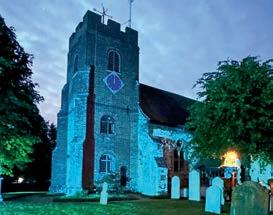

manufacturers’ literature and methods of work.
One of the lights was not positioned at the optimum location, which was highlighted at the design stage; so when carrying out the works we created a new concrete base and trenched the cable discreetly around the perimeter wall.
Two new 100W RGBW architectural floodlights were installed to illuminate the west and south sides of the tower and a further fitting placed to illuminate the south elevation of the church. The fittings are controlled with a hand-held RGB+CCT 4 Zone Touch Controller, with smooth dimming function and dynamic colour-changing programmes.
The existing timeclock was replaced with a Sangamo Suntracker astronomical timeclock, which automatically adjusts throughout the year, operating the lights from sunset until a chosen time.
The church members and village residents were very pleased with the results and look forward to illuminating with colour the various Christian celebrations throughout the year. q

The range of products and systems available for collections storage has increased considerably over the past decades. A number of innovations in the field result from advances in research into preservation in other industries – in particular food technology and electronics. Many of those innovative materials are now available to the heritage industry, along with more traditional acid-free storage boxes and products to provide a range of long-term storage solutions. Here, Stuart M Welch, founder and development director of Conservation By Design Ltd, looks at developments over the past half-century.
[IN EUROPE during the mid-1970s there was a shortage of high-quality conservation materials. The development and introduction of new products constituted a challenge, especially when there was little commercial enthusiasm for investing in such a small and specialist market. Now, 50 years later, new standards have been set. Most professionals involved in heritage preservation recognise that investment in good-quality materials for storage is both essential and cost effective in the long term.
Of the many innovations in conservation in those pioneer days the most important was the development of acid-free papers, boards and boxes, such as those developed and sold by Conservation By Design. The use of corrugated storage boxes, even if they are acid free, should be avoided because they offer little protection against fire, flood or insect damage. The use of stable archival polyester plastics such as Melinex and Mylar was also introduced to replace unsafe plasticised PVC products, which damaged photographic collections.
Today there is a growing market in Europe for high-quality materials for conservation. There are now storage methods available that are proactive as well as protective. Since the beginning of the 1990s new proactive storage products have been developed to protect sensitive products from corrosion or oxidation. Research into the field of anoxic enclosures is being carried out by many world institutions to investigate how to prevent colour fading by light or the rusting of metals, eradication of insects or the prevention of mould growth. One such example is the use of oxygen scavengers within multi-layer oxygen barrier films and foils.
Corrosion Intercept is another product developed to prevent corrosion. It uses highly-reactive copper particles bound in polyethylene film to attract and neutralise corrosive gases, to protect metals and CDs, for example, by acting as a preferential corrosion site.
These proactive storage products provide answers to many of the heritage industry’s storage problems. When combined with solid board acid-free boxes they offer great protection and can greatly increase the lifespan of their contents.
The performance of traditional and new materials during natural disasters involving water and fire has also to be considered in deciding appropriate storage.
Silica gel is the most common moisture scavenger and activated carbon in the form of Activated Charcoal Cloth or the new Puritan Pads developed by Conservation By Design offer a simple solution to atmospheric pollution in storage containers or display cases, to protect silver and other items vulnerable to tarnishing.
Conservation by Design Limited regards ‘open-minded’ storage as the answer to problems of housing collections of artefacts in the 21st century. The firm has always worked with a range of clients representing museums, art galleries, artists, private collectors and family historians to find the optimum storage methods, using innovative design and the best materials that the budget would allow. In a world of rapidly developing materials and techniques there is no finite solution, but rather a process of evolution, as science and technology progress. It is for all of us in the industry to keep our minds open and continue searching for new ways to combat challenges.
It may seem strange for a box manufacturer to advocate a storage system other than a box, but the aim should be to supply the optimum method of storage for objects while also complying with the requirements and budget of the client. In most cases the choice is likely to be a standard box, but in some instances a more open-minded, creative approach may offer a better solution. A big flexible bag may be more suitable than a big rigid box.
The unstable nature of many of the materials used to create 20th-century objects dictates that new methods of storage must be found if they are to survive. These new materials also need to be protected against traditional threats from fire and flood and a solid board archival box still offers the best and most affordable protection today. q
• For more information contact Conservation By Design Limited on 01234 846 300. Alternatively email info@cxdinternational.com or visit www.cxdinternational.com





Wild bird activity can pose a number of risks to churches, cathedrals, heritage buildings and the people who use them, writes Natalie Bungay, technical manager at the British Pest Control Association (BPCA).

[THE MOST COMMON BIRD species that causes problems in and around heritage buildings is the feral pigeon. A descendant of the wild, cliff-dwelling rock dove, the modern-day pigeon is found in towns and cities across the UK. Often classed as a nuisance in public places such as town centres, where they sometimes gather in large numbers, pigeons are also a public health risk.
Ornithosis, listeria and e-coli are among the diseases that can be transmitted to people from pigeons and their droppings which also, when dry, can become airborne in small particles, and in some cases may cause respiratory complaints such as psittacosis. Droppings can pose a slip risk, and are acidic, which means they can corrode or erode metals, stonework and brickwork.
Pigeon nesting materials can cause problems, such as blocked chimneys, flues and guttering. That may result in issues with carbon monoxide or water overflow, as well as potentially harbouring a secondary infestation of parasites such as mites, ticks, fleas or beetles.
Under the Wildlife and Countryside Act 1981 it is illegal to interfere with a wild bird, their nest or eggs, so BPCA always recommends a ‘prevention rather than cure’ approach in partnership with a BPCA member, who will have the knowledge and experience to ensure any measures deployed are safe, legal and appropriate to the site.
Pigeon prevention and proofing are highly specialised skills, with a variety of tools and techniques available to deter wild birds by removing food sources and blocking off areas where they perch or roost. Barriers, spikes, nets and wire, when professionally installed, have proved extremely effective. Active systems such as shock strips, audible scarers and optical gels

have been used to create negative associations in birds attempting to land or roost on buildings. When selecting the right proofing technique, it is important for the pest professional to assess each site on its own merit, taking into account the building’s status, architecture and public visibility. Not only does the proofing need to be effective, it also needs to comply with any building requirements and be as attractive as possible.
If a building has particular heritage status, such as being listed, then the installation may require permission for certain aspects, such as drilling into brickwork or installing something that is not original or in keeping with the building’s heritage status. That all needs to be worked out in the planning stages and advice gained from the appropriate authority for said building.
Another consideration will be the aesthetic appeal – it may not be appropriate for an ornate building to have visible plastic spikes poking out from the window ledges. A more appropriate solution may be electric tracks or fire gel, which are barely visible from the ground but provide effective prevention of birds landing. Netting requirements can also be adapted, colour wise, to offer an almost invisible proofing technique: if it is backdropped by the right colour of course!
Another option for prevention may be the use of birds of prey (falconry), which would negate the need for permanent building fixtures and associated permissions. The use of a bird of prey would have to be regular, at intervals decided by the falconer, to effectively disperse the pigeon population and keep them away.
However, as with many methods of control, those deterrents can become less effective over an extended period, so building a relationship with a pest professional can be useful in ensuring
new strategies and methods are introduced to maintain efficacy.
In cases where an infestation has become severe, a pest professional may have to consider last-resort control methods such as shooting or trapping, in line with the relevant legislation.
All BPCA members are endorsed by the government’s TrustMark scheme and must:
• Carry the correct insurances
• Be trained and qualified technicians
• Be assessed to the British Standard in pest
• management EN 16636
• Follow BPCA’s Codes of Best Practice
BPCA members who specialise in bird control will understand the regulations, be able to identify the species and have a working knowledge of their biology and behaviour, as well as creating a management strategy using proofing and control techniques to deal with any current infestation and prevent recurrence.
Dealing with a bird infestation can present a number of challenges, from the health and safety risks posed by bird guano to working at height, which is why we urge Parochial Church Councils and the owners and volunteers in all heritage buildings to choose a BPCA member to undertake this type of work.
As well as conducting a thorough survey and risk assessment with recommended actions, a BPCA member will consider the relevant legislation, ensure any permits or licences are obtained and use PPE and RPE as needed.
Clearance of bird-fouling requires its own specific risk assessment and an appropriate waste-carriers licence should be held, with waste disposed of in line with local authority guidance. q
[
“WHILE HAZARDS such as insect infestation, floods and severe weather can endanger the future existence of traditional buildings, no other hazard is quite as destructive as fire. Given also that most fires are followed by water damage (the residual effect of firefighting water which usually has to be applied in large quantities at high pressure) it follows that those who own, occupy or manage traditional buildings (or those that advise them) have very special responsibilities to discharge and ensure that Scotland’s built heritage remains intact for the enjoyment of future generations.”
That introduction to Part I of Historic Environment Scotland’s Fire Safety Management in Traditional Buildings echoes similar sentiments throughout the UK. Consequently, heritage organisations in all the constituent nations have issued advice documents to owners and managers of historic buildings.

Fire Door Safety Inspection Services
T: 07791 097 961
E: allan@fdsis.co.uk
W: www.fdsis.co.uk


That advice has and does evolve as changes to fire safety legislation reacts to disasters and subsequent inquiries.
The aim of fire precautions in historic buildings remains the same, however. That aim is summed up by an advice document from Derbyshire Fire and Rescue Service: “In most of their work, architects and fire consultants will try to achieve a balance between the simplest, most cost effective means of minimising the risks of fire and the effect of this protection on the building's usefulness, its earning capacity and its real estate value. In a historic building, the same criteria will be addressed, but in a way that causes minimal or no damage to the buildings special quality.”
A number of causes of fires in historic buildings have been identified by Historic England in the Fire Advice section of its Technical Guidance. Possibly the most upsetting is arson.
According to the advice: “Fires caused by arson can have a lasting negative impact on communities. In the case of historic buildings, the effects of arson are often compounded with the loss of cultural, social and artistic heritage.”
One of the areas of the country identified as suffering most from arson is the North West. In part that is due to the number of unoccupied and derelict former mill buildings.
That is why it was Historic England North West who worked with the region’s fire and emergency services to produce the guide Arson Risk Reduction: Heritage Properties in the North West, available from Cumbria County Council at www.cumbria.gov.uk q

By Steve Holland, managing director of Somerset-based Ace Defence Ltd.
[ HISTORIC CHURCHES across the UK are facing an escalating threat: the theft of York stone and valuable metals.
York stone, a beautiful and durable sandstone synonymous with English ecclesiastical architecture and popular for construction and landscaping, is a prime target for thieves due to its high demand and value. Its theft weakens the structural integrity of the building fabric.
The stone slabs can cost up to £400 per square metre to replace, which also accounts for their value to others. In one case, an organised gang of three men was sentenced for stealing more than £100,000 worth of York stone from eight historic churches across Lancashire, Derbyshire and Staffordshire between January and March 2022.
Meanwhile, the continuing high prices of metals like lead and copper have made them equally attractive targets for criminals. Lead, often used in church roofs, is particularly vulnerable and its theft can result in extensive water damage and huge repair costs. Copper wiring, lightning conductors and other fixtures are also frequently pilfered. There has been a small decrease in theft from church roofing, but that is mostly due to the efforts of insurers like Ecclesiastical to promote the use of security measures.
In a press release issued in June 2024, Helen Richards, church operations director at Ecclesiastical Insurance, said: “Theft from church buildings can have a heartbreaking impact, both on the volunteers and congregation who give their time to worship at the church and also to the potential loss of heritage. We still want churches to be open during the day to their communities, congregation and potential visitors, but we must all be aware of the risks. It is critically important that churches follow our risk management advice to protect themselves.”
Ecclesiastical’s risk management team advises churches to take the following steps:
Keep your church secure: At night, lock your church doors, windows and any external gates. Installing security lights and keeping the exterior well lit can deter criminals, as can applying anti-climb paint. Also, consider installing intruder alarms and CCTV, all remotely monitored by an alarm receiving centre that can alert the church if there is an incident.
Report suspicious activity and encourage the use of church buildings: Use the building as much as possible for church and community activities. Regularly occupied and used buildings may be less vulnerable to attacks.
Practise good housekeeping: Keep internal doors shut and locked when not in use; put any valuables into secure safes; remove any equipment that could be used to access the church, such as ladders used for maintenance.
Carry out regular external inspections of your church buildings and grounds: Regularly check your buildings and report any criminal damage to the police and your insurers as soon as possible. Cut back vegetation on a regular basis so the building can be seen by people passing who may spot suspicious activity.
Repair any criminal damage to the church building immediately: A damaged building is at risk of further attacks, including arson. Ensure any graffiti or other signs of anti-social behaviour are removed quickly.
Report theft to the police and insurer: In the event that the worst happens, make sure you report the break-in to the police so they can visit and collect forensic evidence to support any

investigation. It’s also important to let your insurer know so they can help process the claim.
As one of Ecclesiastical’s approved installers of video surveillance systems, Ace Defence work with churches of all sizes, as well as heritage and other buildings, to help them secure their property from damage and theft. q



[ECCLESIASTICAL INSURANCE played a crucial role in supporting the restoration efforts at Worcester Cathedral after the damage caused by Storm Arwen in November 2021. The severe winds tore part of a pinnacle from the cathedral’s tower, resulting in significant structural damage. Through collaborative efforts, skilled craftspeople successfully restored the cathedral.
The fallen stonework, weighing approximately 0.5 tonnes, had fallen from a height of over 30 metres. The immediate priority was to ensure the safety of the building and temporary measures were put in place to protect it from further damage.
Preserving the cathedral’s history was of utmost importance to Ecclesiastical during the restoration process. Extensive discussions with structural engineers led to the construction of a permanent steel frame within the roof void to support the vaulted stone ceiling. Metal hangers and a flat metal plate reinforced the masonry, ensuring structural integrity.
Efforts extended beyond the damaged area to protect the cathedral’s organ. Around 1,500 organ pipes, contaminated with dust and debris, were carefully extracted and cleaned off-site. A digital organ was sourced for continuity of services. Once repairs were completed, the organ pipes were reinstalled.
In March 2022 the quire reopened, marking a significant milestone. The cathedral resumed activities, including hosting the Cathedrals’ Workshop Fellowship (CWF) graduation ceremony. The CWF programme, sponsored by Ecclesiastical, emphasises the importance of preserving specialist skills for future generations.
During the restoration, peregrine falcons had nested on the cathedral spire. Ecclesiastical supported the cathedral in putting the restoration of the pinnacle on hold until the chicks had fully fledged. A live webcam allowed


and Mr Lazy.
Carving of the new pinnacle began while waiting for the falcon chicks to fledge. The damaged pinnacle was replaced with a new one crafted by the cathedral’s stonemasons. The preservation of the cathedral’s architectural heritage was ensured, using red sandstone sourced from Hollington quarry in Staffordshire.
Completion of the works was marked by a topping out ceremony, an ancient tradition whereby the final piece of stone is placed and the Dean blesses the stonework. The ceremony took place exactly two years to the day, 27 November 2023, since the damage happened.
Interim Dean, Canon Stephen Edwards of Worcester Cathedral, commented: “We are extremely grateful to Ecclesiastical for their support from the moment the news broke and right the way through the journey. The complexities of the project have been a challenge but the advice, skill and expertise from Ecclesiastical and all our partners have ensured excellent work on a project of huge significance. Navigating peregrines, programming, policies and people with perfection, the finished pinnacle stands tall as a testament to the many professional and skilled supporters.”
The successful restoration of Worcester Cathedral stands as a demonstration of Ecclesiastical’s collaborative efforts with the cathedral. Their commitment to preserving heritage and supporting initiatives like the CWF programme has played a vital role in ensuring the restoration. Worcester Cathedral continues to inspire and serve as a symbol of resilience, thanks to the dedication of all those involved. q
• To read more about this case study visit the website at www.ecclesiastical.com/worcestercathedral



[ ONE OF THE MOST FAMOUS and breathtaking locations to visit in Brighton is the landmark St Bartholomew’s Church. Known for its Gothic Revival architecture, the church was built between 1872 and 1874 and is one of the tallest churches in England.
Despite its simplicity, the interior’s vast open space is awe-inspiring. The church features a large pipe organ and several stained glass windows. St Bartholomew's is a Grade One-listed building, marking its exceptional historical and architectural significance.
Tarrant Group initially became involved with the church by reaching out and introducing our team and their years of expertise. By utilising its advanced techniques, the Tarrant team successfully saved the church a substantial amount of funds while sparing it from the unsightly presence of scaffolding.
Work Tarrant Group has carried out
Tarrant Group’s efforts centred on the large circular window where we removed substantial amounts of vegetation. The vegetation had been causing mortar to crack and deteriorate over time. Following that we undertook tasks such as re-pointing missing mortar and replacing damaged and missing bird spikes. While those tasks may seem minor, they are crucial for preventing further deterioration of the building and preserving its history.
At Tarrant Group, our strength lies in our team’s deep reservoir of knowledge and experience. Spanning generations, our team members range in age from their early 20s to their late 70s, with some having been with us for over 40 years. Collectively, we boast over 150 years of experience. That extensive expertise encompasses a wide range of skills, including working at heights exceeding 400ft restoring historical buildings and churches.
Our proficiency in laddering and rope access methods offers a cost-efficient alternative to traditional scaffolding. So where do we stand as a company? The answer is, we don't fit into a single category, because our services are remarkably diverse. We can offer leadwork, vegetation removal, roofing, restoration, drone and visual inspections, surveys, lightning protection, spire work, bespoke joinery and more. That variety of services ensures that we can meet a wide array of client needs, making us a versatile and reliable choice for any project.
At Tarrant Group we place a high priority on customer service. We ensure our clients are updated throughout any remedial works, providing images and reports to ensure they are fully informed and reassured as to the progress and quality of the work being carried out.
Our expert knowledge is always just a phone call away, available 365 days a year. Whether working with insurance companies or liaising with architects, we are equipped to handle all aspects of communication and co-ordination to ensure seamless project execution.
Choosing Tarrant Group means opting for a team with unparalleled experience, a wide range of services and a steadfast commitment to exceptional customer service. Let us be your trusted partner in achieving your project goals with confidence and peace of mind. q

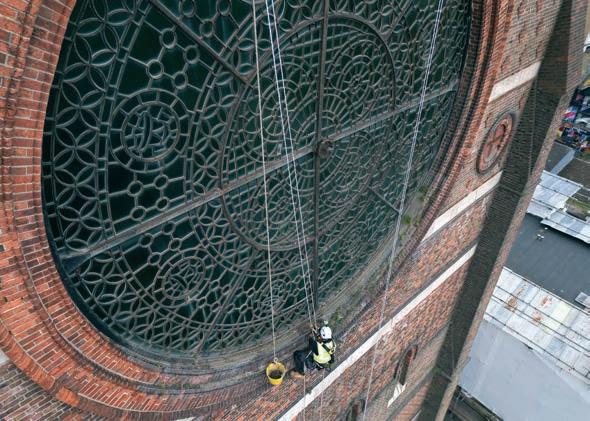


MDS Consulting Limited
• Lightning Protection
• Church Steeple Repairs
• Chimney Inspections
• Drone Surveys
• Anchor Point Testing
• Window Cleaning & Repairs
T: 07833 785257
E: enquiries@mdsconsulting.co.uk
W: www.mdsconsulting.co.uk


2 Victoria Cottages, Silton, Gillingham, Dorset SP8 5DG
Lightning Strike Ltd
Lightning Protection and Earthing Specialist for Churches and Historic Properties
• Earthing Systems
• Surge Protection
• Safe Strike ESE Systems
• Lightning Conductor Testing
• Earthing System Testing
• Soil Resistivity Testing
T: 01158 752686 M: 07581 266493
E: info@lightningstrikeltd.co.uk
W: www.lightningstrikeltd.co.uk
452 Watnall Road, Hucknall NG15 6FQ






Horizon Specialist Contracting Ltd
With over 30 years experience our in-house design team are trained and certified to the current British & European Standards BS EN 62305:2011 for Lightning Protection Systems and BS 7430:2011 for Earthing.
• Lightning Protection Systems and Surge Protection Design
• Testing and Inspection surveys
• Steeplejack maintenance
• Fall arrest safety systems



T: 0115 965 7400 E: sales@horizonsc.co.uk W: www.horizonsc.co.uk
Unit 7, Burma Road, Blidworth, Nottinghamshire NG21 0RT

• Lightning Conductor Engineers
• Steeplejacks • Flagpole Specialists
• High Level Access
Providing lightning protection and steeplejack services since 1978.

• Churches
• Cathedrals
• High Rise Office Blocks
• High Rise Residential Blocks
Steeplejacks and Lightning Conductor Engineers
We specialise in:
• Lightning protection systems
• BS EN 62305 & BS 6651
• Earthing and resistivity testing
• High maintenance work
• All rope access work

• Flagpoles
• Full architectural surveys & cover meter surveys
T: 01225 761330 M: 07973 397770

E: info@wiltshiresteeplejacks.co.uk W: www.wiltshiresteeplejacks.co.uk 44 Eastbourne Road, Trowbridge, Wiltshire BA14 7HW
& S Steeplejacks Ltd
Over 30 years experience in the Design & Installation of Lightning Protection Systems.
• Annual Testing
• Inspection & Maintenance
• Surge Protection
• Height Safety Systems
Churches, Schools, Hospitals, Universities, Colleges





T: 01761 437796 M: 07974 184449


E: graham@gnssteeplejacks.co.uk W: www.gnssteeplejacks.co.uk
Unit 3, Bath Business Park, Peasedown St John, Somerset BA2 8SF
Direct Strike Ltd
Lightning Protection and Earthing Solutions
• Lightning Protection
• Inspection & Maintenance
• BSEN 62305:2011
• Consultancy & Design Services
• Supply & Installation
• Earthing Systems
• Height Safety & Fall Arrest Systems
• Surge Protection







Head Office: 01461 337951 Rep of Ireland: +353 45 913 129
E: enquiries@directstrike.co.uk W: www.directstrike.co.uk
18 Canberra Road, Gretna, Dumfriesshire, Scotland DG16 5DP
The UK’s largest independent Lightning Protection & Earthing contractor



Design, installation and maintenance
• Lightning Protection
• Surge Protection

• Schools
• Hospitals
• Towers
• Sports Centres

A C Wallbridge & Co Ltd


T: 01722 322750 E: office@wallbridge.uk W: www.wallbridge.co.uk
Unit 7, Centre One, Lysander Way, Old Sarum, Salisbury SP4 6BU
• Earthing Services
• Height Safety Services
Offices in London, Sussex, Essex and Bristol.
T: 020 8371 0001
E: info@cuttings.co.uk W: cuttings.co.uk


10-12 Arcadia Avenue, Finchley Central, London N3 2JU
For all of your lightning protection and access requirements, we are here to help.
• Lightning Protection
• Earthing Systems
• Height Services
• ATV Access

North(Head office): 01461 800323
South: 01582 511036 N.E: 01914 661145



E: info@lightningconductor.co.uk W: www.lightningconductor.co.uk
Ivinghoe Business Centre, Houghton Regis, Dunstable LU5 5BQ


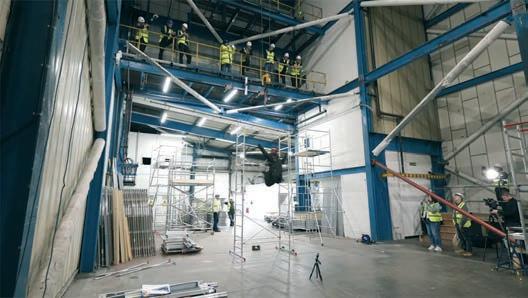
[ WORKING AT HEIGHT remains one of the biggest causes of fatalities and serious injuries across the UK. The main causes include falls from ladders and through fragile surfaces. The Church of Scotland has identified falls from height as the most significant hazard in many of its church buildings, resulting in a number of serious injuries and even fatalities.
Guidance within its Health and Safety Toolkit includes subject matter specific to working at height and is aimed at volunteers. It also recognises the particular risks posed by the nature of many church buildings.
The document states: “Historic stairways, fixed and loose ladders and the lack of guardrails and unprotected edges at height will continue to be a significant hazard for many church buildings constructed before modern building regulations. The historic aesthetics of the buildings and any inherent hazards that are difficult to control need to be suitably risk assessed.”
In particular, access to roof spaces, clocktowers and spires should be restricted and closely monitored, the guidance notes. Only contractors, their employees and volunteers who have undergone specific training in working at height should be allowed access. They should also be supplied with the relevant safety equipment and PPE required for the task.
The Church of Scotland guidance also addresses issue of volunteers using access towers to work on churches.
“We are aware that some congregations have purchased their own mobile platforms or scaffold towers, which they erect, use and dismantle on their own premises to carry out work at height. It is important that the Charity Trustees are fully aware of the risk and potential health and safety implications of working at height and have sufficient information to make an informed choice before allowing the use of such equipment in their buildings.”
The advice is particularly pertinent in light of a fatal accident in 2021 involving volunteers working at a church on a mobile scaffolding tower. The tower toppled, killing one volunteer at the scene and fatally injuring the other. The accident happened in Peterhead, although not at a Church of Scotland building.
Such accidents prompted PASMA, the trade body for the manufacturers and distributors of mobile access towers, to launch a campaign warning of the dangers of what it calls DIY towers.
PASMA stated: “Unfortunately, despite existing legislation and regulations making clear that all products on the market must be safe and existing design standards being well established, there are still towers out there that are not safe at all. These so-called ‘DIY towers’ are readily available and easy to buy online.”
PASMA released a photograph of a ‘test tower’ (pictured) from which a mannequin fell to the ground because of inadequate side protection. q

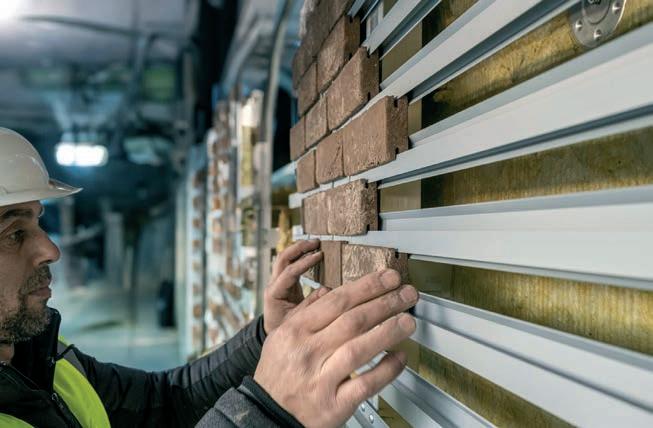
[FABSPEED, a Michelmersh Group brand, has introduced its CMS40 façade system, in collaboration with fellow industry leaders Cladmate Façade Systems.
CMS40 is a lightweight, easy-to-install, cost-effective system that integrates mechanically fixed, non-combustible brick slips into façades to offer the beautiful clay aesthetic that we all know and love. It is suitable for a range of construction projects – from volume high or low-rise or single new build projects to retrofit applications – and can be applied to both indoor and outdoor façades. By seamlessly blending traditional brickwork aesthetics with advanced rainscreen cladding solutions, CMS40 sets a new standard in architectural versatility and performance.
The system offers numerous benefits, including reduced on-site labour, and thus shorter project durations, installation cost savings, improved production safety and quality procedures, enhanced precision and environmental advantages through waste reduction, system recyclability and re-use.
Pairing the innovative CMS40 system with the durability and longevity advantages of clay bricks, in an easy-to-install system, reinforces its appeal in the wider construction industry. Renowned for their strength, fire resistance, thermal and acoustic performance and beauty, clay bricks provide enduring quality alongside their famed long life expectancy.
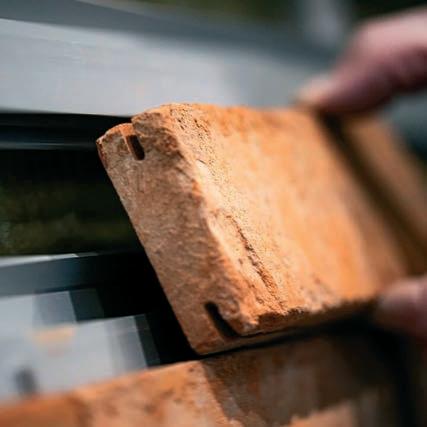
Furthermore, the CMS40 support system incorporates 70% recycled aluminium as its primary component, and as such is fully recyclable, promoting circular principles – similar to its clay brick counterpart. Its dismantlable and reusable nature, coupled with clay brick slips, can lead to a full aesthetic revision with only mortar replacement, ensuring it aligns with sustainable building practices and makes it an ideal choice for secondary applications.
CMS40 comes ready to be adorned with a wide selection of clay brick slip products from Michelmersh’s core range. Additionally, FabSpeed’s team of skilled craftspeople can customise slips from various manufacturers’ clay products, providing tailored solutions to meet every project’s challenges.

With a variety of colours and textures, clay brick slips offer unparalleled design flexibility and adaptability which can evolve over generations while also complementing change in architectural vision. With confidence in CMS40’s versatility, clients can choose a less standard brick bond or even projecting brickwork patterns to give a façade more depth (pictured above).
Certified for fire safety and environmental standards, CMS40 has undergone rigorous testing, including BS 8414-2:2020 and CWCT standards, with BBA certification covering both Parex lime-based and Instamac cementbased mortars. The lightweight framework system not only reduces structural load but also boasts an A1 non-combustible rating, ensuring safety throughout its lifecycle.
CMS40 is available through FabSpeed with components that can be supplied directly from Cladmate to offer an efficient and reliable supply chain.
FabSpeed’s integration within the Michelmersh Group and its decades of readily available expertise on brick finishes and design aspects will ensure that designers looking for a lightweight and innovative prefabricated façade system will be in safe hands. q



[ ON 10 MAY the winners of the 2024 NFRC UK Roofing Awards were revealed, at a spectacular ceremony at the InterContinental London –The O2. The awards ceremony was hosted by stand-up comedian, actor and presenter Hal Cruttenden.
The Heritage category itself was one of a number of categories wherein projects in the ecclesiastical and heritage sectors triumphed. That category was won by Emerton Roofing (Western) Ltd for East Manley Hall in Cheshire (pictured top right).
That project led a charge of ecclesiastical and heritage sector winners. The only church project to be crowned winner was the bell tower of St Andrew’s Church by Matt Timby Ltd, in the Single Ply Roofing category.
The clock tower of Derby Museum and Art Gallery by NRA Roofing & Flooring Services Ltd triumphed in the Leadwork category, while the top prize in the Mastic Asphalt category went to Sumburgh Head Lighthouse & Visitors Centre by BriggsAmasco Ltd (Glasgow).
Other heritage buildings to figure in the winners’ list were in the Bituminous Hot Applied Liquid Waterproofing category, with Rhodes House by Fenland Flat Roofing Ltd working with Sika Ltd, and the Fully-Supported Metal category with a copper dome in Tidworth by Prestige Metal Roofing Ltd.
The Roof Slating category was won by the Grade Two-listed Roundhouse in Leeds by Martin-Brooks (Roofing Specialists) Ltd (pictured bottom right).
A new building that is sure to become a heritage building of the future is Aviva Studios, headquarters of Factory International in Manchester. That project won the Sheeting and Cladding category for Lindner Prater Ltd.
Congratulating all the winners, NFRC CEO James Talman said: “With the ever-increasing focus on competency, the winners of this year’s UK Roofing Awards are perfect ambassadors of installer excellence.
“The standard of entries is higher each year due to the popularity and prestige of the Awards, and this, combined with the independent scrutiny of the expert judges, makes winning an exceptional achievement. Many congratulations!” q


[ FOLLOWING A TOUGH SET of regional heats, eight skilled roofing apprentices have been selected for the SkillBuild Finals, which will take place from 19-21 November at the Marshall Arena, Milton Keynes.
Five of the successful finalists were from Leeds College of Building: they are Levente Szasz, Sam Jinks, George Jewitt-Knott, Daniel Sperry and Alfie Waddington. They will be joined in the finals by Hamish Morgan of Edinburgh College, Jack Mayo of South Devon College and Joe Gallagher of Bolton College.
Ben Rowlands, technical manager for slating and tiling at the National Federation of Roofing Contractors (NFRC), attended all seven of the regional heats across the UK.
He commented: "There was an immense display of talent shown this year, which is a testament not only to learning providers for delivering outstanding training, but to each of the contestants. Their drive and ambition to excel in a competition known for its high expectations of standards and workmanship was clearly demonstrated, and I am
Martin-Brooks (Roofing Specialists) Ltd
T: 0114 244 7720
E: mb@allroofing.co.uk
W: www.martin-brooks.co.uk
Ross Street, Darnall, Sheffield, South Yorkshire S9 4PU

confident that the finals will be another example of exceptional talent from these young men. Myself and NFRC wish each of them the best of luck in November.”
In total, SkillBuild 2024 had over 1,000 registrations across 10 construction trades, with 39 entrants in the Roof Slating and Tiling category from 13 colleges or training centres. There were seven regional heats. q
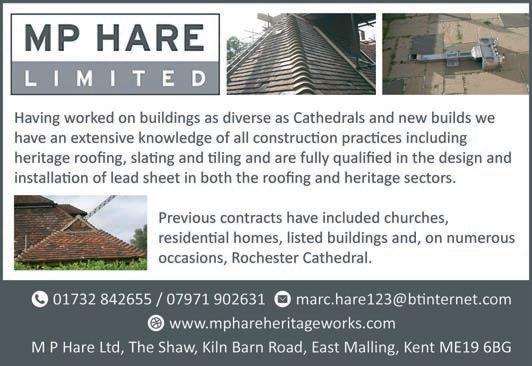
[ NATIONAL CONSTRUCTION TRAINING SERVICES (NCTS)
has now partnered with SIG Roofing to provide even greater UK coverage of its courses and qualifications. On offer will be a fiveday lead welding and bossing course and technical seminars. The initial programme, starting in August, will be delivered from SIG’s Cardiff, Dudley and Dundee branches.
The technical seminars are aimed at those supervising the installation of leadwork or those responsible for specifying. The seminars will include a theoretical session combined with hands-on practical appreciation in the workshop.
Unsurprisingly, the On-Site Assessment and Training (OSAT) programme is proving as popular as ever. It provides an efficient route for experienced workers without formal qualifications to obtain recognition of their skills by obtaining NVQ Level 2 or Level 3. Assessments are carried out on site, reducing the amount of time the candidate must spend away from normal work.
NCTS continues to forge ahead with on-going training provision and the expansion of its training facilities. The range of courses available at each centre covers sector-specific training, such as qualifications in lead and hard metals, slating and tiling, and health and safety.
They range from bespoke courses through to Heritage Specialist Applied Programmes (SAP). If they are CITB registered, contractors can claim up to £7,000 of CITB funding per student.
New courses are added wherever there is a demand, such as ornate slating courses, lead casting courses and estimating. These new and existing courses have necessitated the recruitment of


additional tutors and assessors, who together cover the entire range of the training and assessment programmes at the two training sites, in addition to the company’s national mobile training delivery.
In the past, experienced lead and hard metal workers were issued with CSCS cards through the industry accreditation process – also known as ‘grandfather rights’ – via employer recommendation rather than the achievement of a recognised qualification. CSCS closed that process to new applicants in 2010, but existing cardholders have been allowed to renew on the same basis.
From 1 January 2020 all cards renewed under industry accreditation will expire on 31 December 2024 and CSCS stopped issuing the cards from 30 June.
Anyone whose card has already expired or who wishes to prepare for the December deadline should not hesitate to contact NCTS to discuss their personal circumstances. q
• For further details on courses and venues call 01992 801914, email training@ncts.org.uk or visit www.ncts.org.uk . Alternatively, contact Amanda Johnston at amanda@ncts.org.uk
[ WHEN WORKING WITH LADDERS in churches or old buildings – which often have high ceilings and hard-to-reach places – it’s essential to follow safety guidelines, to prevent accidents and ensure the well-being of those involved. There are some key points to consider.
Choose a ladder that is the appropriate height for the task: ensure it can safely reach the desired surface. Inspect the ladder before each use, checking for any signs of damage or wear and tear, and replace any damaged components.
• Place the ladder on a level surface, free from
• any obstructions or hazards.
• Ensure the surfaces supporting the ladder are
• safe, ie stable and firm.
• Position the ladder to ensure its stability and
• prevent slipping.
• If using an extension ladder it should extend
• sufficiently above the landing place, unless
• there’s provision for an adequate handhold.
Avoid common mistakes
• Avoid overreaching while on the ladder: keep
• your body centred between the rails.

Emergency procedures
• Ensure that emergency procedures are clear and can be followed by
• Maintain three points of contact (two feet and one hand or two
• hands and one foot) while climbing or descending.
• Do not use ladders near doorways, walkways or high-traffic areas.
• Avoid distractions while on the ladder, such as using a phone.
• The practice of ‘footing’ a ladder – where a second person places a
• foot on the bottom rung – is no longer accepted as good practice.
Ensuring the safety of bell tower ladders is crucial to prevent accidents. There are some steps you can take to check and maintain the safety of your ladder.
Visual inspection
• Inspect the rungs: Look for signs of damage or excessive wear on
• the ladder rungs. Ensure they are secure and not loose.
• Check fixings: Examine the top and foot fixings. Make sure they are
• tight, robust and securely attached.
• Remove obstacles: Clear any oil, dirt, grease or paint that could
• cause slips and falls.
• both ringers and other people in the tower.
• Display signs if anyone is working at higher levels in the tower.
Safety tips for ringers
• Maintain three points of contact when moving.
• Test footholds before applying weight.
• Be cautious of damaged or rotten floorboards.
•Avoid carrying large or heavy items up the ladder; use ropes instead. Remember, safety is everyone’s responsibility and collaboration between ringers and church authorities is essential for maintaining a safe bell tower environment.
Safety is paramount when working at height. Take the necessary precautions, and if you have any additional questions feel free to seek advice from professionals or relevant authorities.
Of course, you could consult the expert: Brian at Nimrod Training Providers has been sharing his expertise for decades and would be happy to offer his training services to suit your needs regarding all health and safety issues. Drop him a line at info@nimrod-training.co.uk or visit the website at www.nimrod-training.co.uk. q

[
FEARS HAVE BEEN EXPRESSED by blacksmiths over the possibility the BTEC Level 3 Diploma in Blacksmithing may be phased out next year as part of technical qualification reform. Among the colleges currently running the course is Herefordshire, Ludlow and North Shropshire college – which is recognised as the national school of blacksmithing by the Worshipful Company of Blacksmiths. Its deputy principal Jo Ricketts is co-ordinating a campaign to keep the course running.
Writing on the website of the British Artist Blacksmiths Association, its secretary Steve Rook says: “This has only recently come to our attention so you are probably not aware: the BTEC Level 3 blacksmithing qualification could potentially be withdrawn in July 2025 due to reforms in technical qualifications by the Department of Education. Currently there is no replacement.
“This qualification is critical to delivering blacksmithing training in the UK, which so many smiths today have benefited from. Without the BTEC Level 3 some institutions may find it difficult to keep delivering blacksmithing training.”
Steve urges all smiths to write to Jo Ricketts offering their support. The website carried a template for a letter of support that smiths can download.
The two-year BTEC Level 3 course provides a grounding for either further study at degree level or direct entry to the industry as either employee or self-employed blacksmith.
According to the college’s description: “You will learn a range of forging skills, from tool making to traditional fire welding techniques over the two years, culminating in a final project in which you will plan and make a large-scale final piece to your own design and specification. The second year also introduces restoration and conservation, in
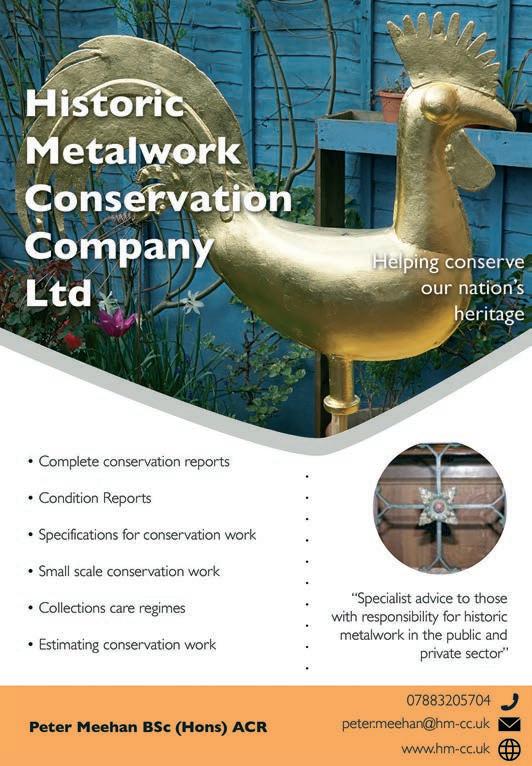

addition to a business studies module giving you the skills necessary to manage your own business.”
Popular modules include Blacksmithing and Construction Skills; Large Scale Design & Make; and Repoussé, Restoration & Conservation.
Steve Rook added: “Please also ask any smiths you know who have benefitted from training on the Level 3 at Hereford and Plumpton to send a support letter in. It’s critically important we don’t lose this qualification.” q
• For further details on the campaign visit the website at www.baba.org.uk/withdrawal-of-btec-level-3
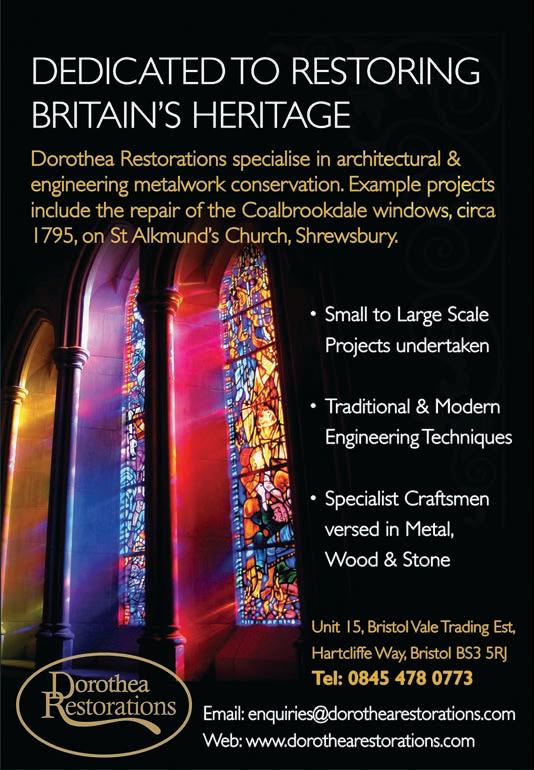

[THE HERITAGE-FRIENDLY waterproofing of basements and cellars sited partially or fully underground, and subject to on-going moisture problems, can come with significant technical challenges. The primary challenge is how to keep water out of the building without causing long-term damage to the building fabric.
The main moisture sources affecting old basements and cellars are:
• Penetrating dampness: being underground, cellar walls are in
• permanent contact with the damp soil.
• Rising damp: old walls underground are also subject to rising
• dampness and salts from the ground.
• Water ingress: aging, dampness and on-going salt crystallisation
• break down the pointing and the building fabric, resulting in water
• ingress and leaks.
• Condensation and mould: on-going evaporation results in high air
• humidity, which often results in condensation.
• Dampness caused by incorrect past renovations: modern
• renovations (cement pointing or tanking, impermeable membranes
• etc) makes moisture accumulate behind the tanking, ‘pushing’ the
• water up and resulting in other dampness problems.
There are many basement tanking solutions on the marketplace. A common approach is barrier protection (Type-A waterproofing), which uses a cementitious slurry or a flexible waterproofing membrane (bitumen or rubber) to deal with the water. Another common solution is drained protection (Type-C waterproofing) which is applied when liquid water penetration is present. It involves a cavity drain membrane and sump pump combination to pump out liquid moisture.
However, old buildings require a different approach as none of the modern solutions are breathable. Modern waterproofing materials
– cement, tar, plastic membranes etc – block water; but being nonbreathable they trap humidity, which can lead to the accumulation of moisture behind the waterproofing layer, damaging the fabric of old, historic buildings in the long term.
The lime equivalent of modern tanking solutions was developed by the Romans about 2,000 years ago. Being outstanding architects and builders, the Romans observed that adding to lime certain volcanic sands and ashes – also known as natural pozzolans, which are highly porous and breathable lava materials – can significantly alter the properties of lime while retaining its breathability. Those lime plasters are suitable for a very wide range of applications, including many waterproofing applications, which are solved today with modern Portland cement.

lime
were extensively used by the Romans for centuries in very demanding environments, including sewers, ports, spas and aqueducts, and they have survived for many centuries. They have also been widely used in Venice, as they perform extremely well in the humid and aggressive environment of the Venetian lagoon. The longevity of the plasters is also outstanding: many of them lasting for centuries, much longer than modern cement.
One particular waterproofing project concerned the old coal storage area of a listed church, sited next to the crypt. The 150-year-old coal store was leaking badly, and due to liquid water ingress had become practically unusable. Moreover, the water that found itself into the room started affecting the adjacent crypt.
About three years prior to Core Conservation’s involvement in the project, there was an attempt to remedy the water ingress with modern tanking. The intervention was unsuccessful as the dampness problems returned shortly thereafter. A more robust solution had to be found, and being a listed church the solution ideally had to be conservation-friendly.
After an initial survey aimed at determining the extent of the problem, the renovation specifications were put together and a completely heritage-friendly solution was proposed to the client. In terms of the waterproofing, the proposed solution was based on the Rinzaffo MGN Roman waterproofing plaster, that can stop liquid moisture ingress while letting the walls breathe. The technical details and specifications of this lime plaster are available to read online at www.coreconservation.co.uk. The same material was also applied to the floor, creating a waterproof yet breathable dry floor base.
Once the waterproofing coat dried Core Condervation applied a cocciopesto plaster (lime mixed with brick dust) as a second coat. That has excellent hygrothermal properties, well-known since antiquity. In fact, cocciopesto plasters were used in Roman baths as it is moisture resistant and an excellent internal humidity regulator, while also being aesthetically very pleasing.
The project was a great success. The works were completed early November. Three months later, in early February, despite a very wet and rainy winter the area stayed completely dry: a testament to the performance of traditional Roman conservation technology. q
• Read more about conservation-friendly materials and solutions at www.coreconservation.co.uk

[NEW BESPOKE STEEL WINDOWS by Clement Windows Group were selected recently for the refurbishment of the Grade Two-listed Ladywell Convent in Surrey.
Ladywell Convent is the Motherhouse of the Franciscan Missionaries of the Divine Motherhood (FMDM) congregation, an international religious congregation of Catholic women who proclaim the joy and freedom of the Gospel in the spirit of Saints Francis and Clare of Assisi. Situated in the beautiful Surrey Hills, the convent offers hospitality to returning missionaries and visitors and is also the site of La Verna, a home for elderly sisters and those who support them.


Previously named Tuesley Court and bought by the FMDM in 1956, Ladywell is Arts and Crafts in style and an oasis of calm and tranquillity just outside Godalming.
The recent extensive refurbishment was carried out to the residential and conference buildings on the site, ensuring their suitability for an aging group of sisters. Two new support buildings were also constructed.
Side-hung casements from the Clement SMW range, with genuine 12mm flat leads, were installed in the new Greccio building (pictured), polyester powder painted in RAL 9005 (Jet Black) semi-gloss, with the handles, hinges and peg stays powder coated to match the frames. Windows from the Clement EB20 steel window range with 12mm oval leads were installed in the staff building, also painted RAL 9005.
Michael O’Brien from main contractor O&D Construction commented: “Steel windows manufactured by Clement were the right choice because of their close match to the existing heritage windows at Ladywell Convent. The team at Clement did a great job: they delivered the project on time and there were no issues.”
The Clement Standard Metal Window (SMW) range is a stylish solution for aesthetically-sensitive historical projects. SMW windows are used primarily for highly-sensitive replacement work in Conservation Areas and on listed buildings, where a suitable geometric match is required and double glazing is not an option.
The Clement EB20 steel window range was created for fenestration projects where a traditional steel window appearance is required, replicating the look of original or existing windows while simultaneously providing all the advantages of 21st-century technology. EB20 windows are manufactured with exceptionally slim frames. The 20mm insulated glass units mean that the largest possible glazed area is provided, thereby optimising solar gain and saving energy through the reduced use of artificial lighting.
A most versatile and popular product, EB20 windows are appropriate for both refurbishment and new build projects. The 20mm glass offers an increased ‘shadow line’ which can be required for some heritage projects.
Clement Windows Group manufactures an innovative range of steel windows, doors, screens and conservation rooflights, specialising in conservation work for both private residences and commercial projects.
The company provides a complete service – from the provision of technical drawings through to manufacture, installation and after sales support – whether the project is a traditional restoration scheme, one involving listed buildings, in a Conservation Area or a new build. As well as traditional hot-rolled steel windows and doors, Clement manufactures Jansen cold-formed, thermally-broken steel profile systems for sites requiring greater insulation and security. q
• For more information call 01428 643393; email info@clementwg.co.uk; or visit clementwindows.co.uk















BUILDING CONSERVATION & RESTORATION








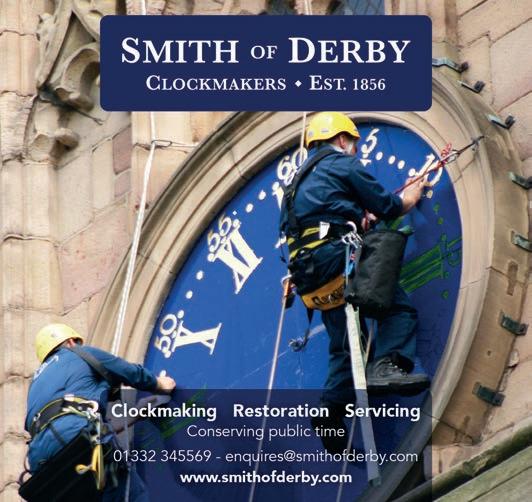






















• Lightning Protection
• Church Steeple Repairs
• Chimney Inspections
• Drone Surveys
• Anchor Point Testing
• Window Cleaning & Repairs
T: 07833 785257
E: enquiries@mdsconsulting.co.uk
W: www.mdsconsulting.co.uk


2 Victoria Cottages, Silton, Gillingham, Dorset SP8 5DG
We provide consultation, installation and aftercare of lightning protection systems, in accordance with the BSEN 62305 code of practice. A high quality, competitively priced, safe and well co-ordinated service.
• Free design & risk assessment
• Surge protection services
• Aftercare & maintenance



T: 0161 302 8766 / 07487 787 854

E: ian.wimpeney@raidenlps.co.uk W: www.raidenlps.co.uk
Unit 2 Ind Estate, Marsland Street, Hazel Grove, Stockport, Cheshire SK7 4ER
Earthing Equipment Supplies Southern Ltd

is a well-established, ATLAS accredited, company offering a wide range of lightning protection services. ATLAS is the UK governing body for lightning protection. 30 years trading.
• BS EN 62305 2012
• System Installation
• Upgrading
• Remedial Work
• Testing
• Earthing
• Materials Supply
• Free Lightning Protection Quotes
• Lightning Protection Risk Assessment
• Design
• Soil Resistivity Testing
• Surge Arrester Quotes
• Site Visits
T: 0118 976 0239 / 07768 566889


E: sales@earthingequip.com W: earthingequip.com Lavender House, Church Lane, Arborfield, Nr Reading RG2 9JA

Igoe Up employ fully qualified Steeplejacks and Rope
Access Technicians to repair and maintain buildings with height. We use a variety of steeplejack access techniques to carry out high-level inspections, surveys, building maintenance and repair services.
• Steeplejack and rope access services
• Stone restoration services
• Church maintenance
• Drone surveys
• Roofing services

T: 01577 531307 / 07481 840581
E: Chris@igoe-up.com W: www.igoe-up.com
17 Dalhousie Gardens, Bonnyrigg EH19 2LP
Over 30 years experience in the Design & Installation of Lightning Protection Systems.
• Annual Testing
• Inspection & Maintenance
• Surge Protection
• Height Safety Systems
Churches, Schools, Hospitals, Universities, Colleges





T: 01761 437796 M: 07974 184449


E: graham@gnssteeplejacks.co.uk W: www.gnssteeplejacks.co.uk
Unit 3, Bath Business Park, Peasedown St John, Somerset BA2 8SF
Steeplejacks and Lightning Conductor Engineers
We specialise in:
• Lightning protection systems
• BS EN 62305 & BS 6651
• Earthing and resistivity testing
• High maintenance work
• All rope access work

• Flagpoles
• Full architectural surveys & cover meter surveys
T: 01225 761330 M: 07973 397770

E: paul.silk@wiltshiresteeplejacks.co.uk W: www.wiltshiresteeplejacks.co.uk
44 Eastbourne Road, Trowbridge, Wiltshire BA14 7HW
Lightning Protection and Earthing Specialist for Churches and Historic Properties
• Earthing Systems
• Surge Protection
• Safe Strike ESE Systems
• Lightning Conductor Testing
• Earthing System Testing
• Soil Resistivity Testing
T: 01158 752686 M: 07581 266493
E: info@lightningstrikeltd.co.uk
W: www.lightningstrikeltd.co.uk 452 Watnall Road, Hucknall NG15 6FQ






• Lightning Conductor Engineers
• Steeplejacks • Flagpole Specialists
• High Level Access
Providing lightning protection and steeplejack services since 1978.
• Churches • Cathedrals
• Schools
• Hospitals

• High Rise Office Blocks
• High Rise Residential Blocks
• Towers
• Sports Centres



A C Wallbridge & Co Ltd




T: 01722 322750 E: office@wallbridge.uk W: www.wallbridge.co.uk
Unit 7, Centre One, Lysander Way, Old Sarum, Salisbury SP4 6BU
Lightning Protection Services
For all of your lightning protection and access requirements, we are here to help.
• Lightning Protection
• Earthing Systems
• Height Services
• ATV Access

North(Head office): 01461 800323
South: 01582 511036 N.E: 01914 661145


E: info@lightningconductor.co.uk W: www.lightningconductor.co.uk
Ivinghoe Business Centre, Houghton Regis, Dunstable LU5 5BQ
Direct Strike Ltd
Lightning Protection and Earthing Solutions
• Lightning Protection
• Inspection & Maintenance
• BSEN 62305:2011
• Consultancy & Design Services
• Supply & Installation
• Earthing Systems
• Height Safety & Fall Arrest Systems
• Surge Protection







Head Office: 01461 337951 Rep of Ireland: +353 45 913 129 E: enquiries@directstrike.co.uk W: www.directstrike.co.uk
18 Canberra Road, Gretna, Dumfriesshire, Scotland DG16 5DP















































